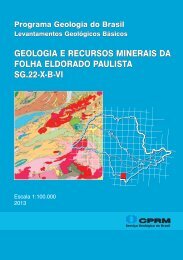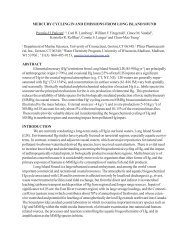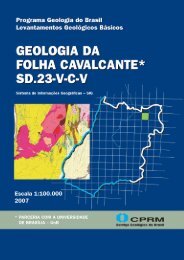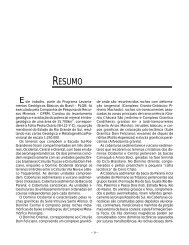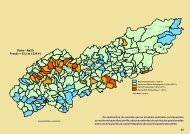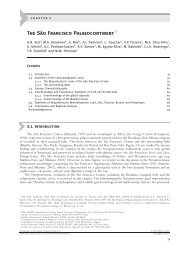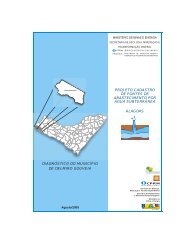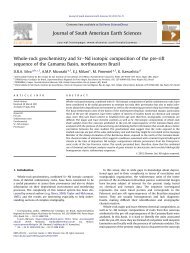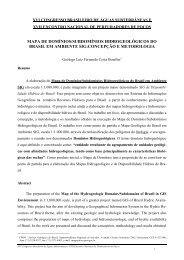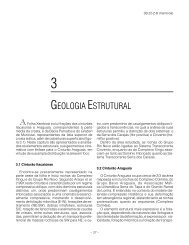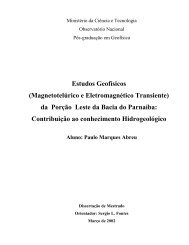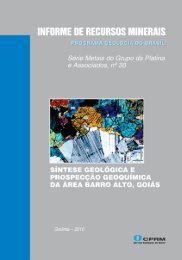Origin of the CO2-only fluid inclusions in the ... - CPRM
Origin of the CO2-only fluid inclusions in the ... - CPRM
Origin of the CO2-only fluid inclusions in the ... - CPRM
You also want an ePaper? Increase the reach of your titles
YUMPU automatically turns print PDFs into web optimized ePapers that Google loves.
<strong>Orig<strong>in</strong></strong> <strong>of</strong> <strong>the</strong> <strong>CO2</strong>-<strong>only</strong> <strong>fluid</strong> <strong><strong>in</strong>clusions</strong> <strong>in</strong> <strong>the</strong> Palaeoproterozoic Carará ve<strong>in</strong>-quartz<br />
gold deposit, Ipit<strong>in</strong>ga Auriferous District, SE-Guiana Shield, Brazil: Implications for<br />
orogenic gold m<strong>in</strong>eralisation<br />
Evandro L. Kle<strong>in</strong> a, ⁎, Kazuo Fuzikawa b<br />
a <strong>CPRM</strong>/Geological Survey <strong>of</strong> Brazil, Av Dr. Freitas, 3645, Belém-PA, CEP 66095-110, Brazil<br />
b CDTN/CNEN, Rua Mario Werneck s/n, Cidade Universitária, Belo Horizonte-MG, CEP 30270-010, Brazil<br />
article <strong>in</strong>fo<br />
Article history:<br />
Received 12 April 2009<br />
Received <strong>in</strong> revised form 31 October 2009<br />
Accepted 31 October 2009<br />
Available onl<strong>in</strong>e 6 November 2009<br />
Keywords:<br />
<strong>CO2</strong>-rich <strong>fluid</strong> <strong><strong>in</strong>clusions</strong><br />
Gold deposit<br />
Quartz ve<strong>in</strong><br />
Shear zone<br />
Guiana Shield<br />
Brazil<br />
1. Introduction<br />
abstract<br />
Carbon dioxide-rich <strong>fluid</strong> <strong><strong>in</strong>clusions</strong> lack<strong>in</strong>g visible H2O atroom<br />
temperature are a ubiquitous feature <strong>of</strong> gold–quartz ve<strong>in</strong> deposits<br />
hosted <strong>in</strong> greenschist to lower amphibolite sequences worldwide. These<br />
<strong><strong>in</strong>clusions</strong> occur, <strong>in</strong> general, as a subord<strong>in</strong>ate population, <strong>in</strong> close<br />
association with cogenetic aqueous-carbonic <strong>fluid</strong> <strong><strong>in</strong>clusions</strong>. The<br />
source and orig<strong>in</strong> <strong>of</strong> <strong>CO2</strong>-rich <strong><strong>in</strong>clusions</strong> and <strong>the</strong>ir role <strong>in</strong> ore-form<strong>in</strong>g<br />
processes have been issues <strong>of</strong> debate. The orig<strong>in</strong> <strong>of</strong> <strong>the</strong>se <strong>CO2</strong>-rich <strong>fluid</strong><br />
⁎ Correspond<strong>in</strong>g author. Tel.: +55 91 3182 1334; fax: +55 91 3276 4020.<br />
E-mail address: ekle<strong>in</strong>@be.cprm.gov.br (E.L. Kle<strong>in</strong>).<br />
0169-1368/$ – see front matter © 2009 Elsevier B.V. All rights reserved.<br />
doi:10.1016/j.oregeorev.2009.10.001<br />
Ore Geology Reviews 37 (2010) 31–40<br />
Contents lists available at ScienceDirect<br />
Ore Geology Reviews<br />
journal homepage: www.elsevier.com/locate/oregeorev<br />
The Carará gold deposit, located <strong>in</strong> <strong>the</strong> Ipit<strong>in</strong>ga Auriferous District, south-eastern portion <strong>of</strong> <strong>the</strong> Guiana<br />
Shield, nor<strong>the</strong>rn Brazil, is a typical orogenic, greenstone-hosted, auriferous quartz ve<strong>in</strong>. M<strong>in</strong>eralisation was<br />
post-metamorphic and syn-tectonic <strong>in</strong> relation to <strong>the</strong> host Palaeoproterozoic (ca. 2.03 Ga) shear zone<br />
developed close to <strong>the</strong> tectonic boundary between a Palaeoproterozoic cont<strong>in</strong>ental arc and an Archaean<br />
block. The deposit style is very simple, consist<strong>in</strong>g <strong>of</strong> a quartz ve<strong>in</strong> and its hydro<strong>the</strong>rmal envelope, which is<br />
composed <strong>of</strong> muscovite and tourmal<strong>in</strong>e; sulphides are rare. Muscovite and tourmal<strong>in</strong>e, <strong>in</strong> addition to gold,<br />
fill small fractures <strong>in</strong> <strong>the</strong> quartz ve<strong>in</strong>. The <strong>fluid</strong> <strong>in</strong>clusion assemblage trapped <strong>in</strong> high- and low-grade portions<br />
<strong>of</strong> <strong>the</strong> Au–quartz ve<strong>in</strong> is ra<strong>the</strong>r enigmatic, consist<strong>in</strong>g <strong>of</strong> one-phase CO 2 <strong><strong>in</strong>clusions</strong> with no visible water at<br />
room or sub-zero temperatures, although small amounts <strong>of</strong> water have been detected by micro-Raman<br />
analysis. In this aspect Carará differs from <strong>the</strong> o<strong>the</strong>r gold show<strong>in</strong>gs <strong>in</strong> <strong>the</strong> same district, which are<br />
characterized by abundant aqueous-carbonic <strong>fluid</strong> <strong><strong>in</strong>clusions</strong>.<br />
The carbonic <strong>fluid</strong> is composed predom<strong>in</strong>antly <strong>of</strong> <strong>CO2</strong> <strong>in</strong> addition to b2 mol.% N2 and traces <strong>of</strong> CH4 and C2H6.<br />
The carbonic <strong>fluid</strong> show very variable densities, which is <strong>in</strong>terpreted to result from post-entrapment reequilibration.<br />
Inclusions <strong>in</strong> <strong>the</strong> high-grade quartz are <strong>the</strong> densest (0.89 to 1.07 g/cm 3 ) and with less effects <strong>of</strong><br />
re-equilibration. These <strong><strong>in</strong>clusions</strong> approximate <strong>the</strong> physico-chemical characteristics <strong>of</strong> <strong>the</strong> parental <strong>fluid</strong> that<br />
started to be trapped at least around <strong>the</strong> amphibolite facies metamorphic conditions and <strong>the</strong>n followed a<br />
retrograde path. Most <strong>of</strong> <strong>the</strong> <strong><strong>in</strong>clusions</strong> appear to have been trapped and/or re-equilibrated at 350 to 475 °C<br />
and 1.8 to 3.6 kbar, which implies a 7 to 12 km depth <strong>of</strong> ve<strong>in</strong> formation and gold m<strong>in</strong>eralisation. Both phase<br />
separation <strong>of</strong> a carbonic-aqueous <strong>fluid</strong> (X<strong>CO2</strong>N0.8) and <strong>the</strong> existence <strong>of</strong> an orig<strong>in</strong>ally <strong>CO2</strong>-dom<strong>in</strong>ated <strong>fluid</strong><br />
could account for <strong>the</strong> observed <strong>fluid</strong> <strong>in</strong>clusion properties and <strong>the</strong> absence <strong>of</strong> H2O-bear<strong>in</strong>g <strong><strong>in</strong>clusions</strong> <strong>in</strong> <strong>the</strong><br />
m<strong>in</strong>eralised ve<strong>in</strong>.<br />
The <strong>fluid</strong> <strong>in</strong>clusion characteristics, comb<strong>in</strong>ed with published geological and isotopic <strong>in</strong>formation, <strong>in</strong>dicate a<br />
deep-seated source for <strong>CO2</strong> that could be mantle, magmatic or metamorphic <strong>in</strong> orig<strong>in</strong>. We suggest that <strong>the</strong><br />
likely sources are <strong>fluid</strong> produced by <strong>the</strong> 2.07 Ga-old charnockites that occur <strong>in</strong> <strong>the</strong> region and/or <strong>the</strong> coeval<br />
high grade metamorphism that is widespread <strong>in</strong> <strong>the</strong> Guiana Shield.<br />
© 2009 Elsevier B.V. All rights reserved.<br />
<strong><strong>in</strong>clusions</strong> is usually attributed to: (1) <strong>the</strong> unmix<strong>in</strong>g <strong>of</strong> immiscible, low<br />
sal<strong>in</strong>ity H 2O–CO 2-bear<strong>in</strong>g <strong>fluid</strong>s at or near <strong>the</strong> solvus followed by postmetamorphic<br />
extraction <strong>of</strong> H2O and preferential trapp<strong>in</strong>g <strong>of</strong> <strong>CO2</strong> <strong>fluid</strong>s<br />
(Crawford and Hollister, 1986; Ho, 1987; Schwartz et al., 1992); (2)<br />
post-entrapment changes that <strong>in</strong>clude dynamic recrystallisation or<br />
stra<strong>in</strong>-<strong>in</strong>duced leakage <strong>of</strong> H2O and diffusion <strong>of</strong> H2O along dislocation<br />
l<strong>in</strong>es (Crawford and Hollister, 1986; Hollister, 1990; Bakker and Jansen,<br />
1991; Johnson and Hollister, 1995); or (3) some comb<strong>in</strong>ation <strong>of</strong> <strong>the</strong>se<br />
mechanisms (Kolb et al., 2000; Kle<strong>in</strong> et al., 2006). In most cases, however,<br />
aqueous and/or cogenetic aqueous-carbonic <strong><strong>in</strong>clusions</strong> are also<br />
present.<br />
A few cases have been documented <strong>in</strong> which <strong>CO2</strong> <strong><strong>in</strong>clusions</strong> are <strong>the</strong><br />
predom<strong>in</strong>ant or even <strong>the</strong> unique <strong>in</strong>clusion type. In <strong>the</strong>se cases, aga<strong>in</strong>,
32 E.L. Kle<strong>in</strong>, K. Fuzikawa / Ore Geology Reviews 37 (2010) 31–40<br />
selective entrapment <strong>of</strong> <strong>CO2</strong> follow<strong>in</strong>g <strong>the</strong> unmix<strong>in</strong>g <strong>of</strong> a H2O–<strong>CO2</strong><br />
<strong>fluid</strong> (Garba and Akande, 1992; Xu and Pollard, 1999), and postentrapment<br />
changes (Klemd and Hirdes, 1997; Wille and Klemd,<br />
2004) are <strong>the</strong> explanations used to describe <strong>the</strong> observed characteristics<br />
<strong>of</strong> <strong>the</strong> <strong>fluid</strong> <strong><strong>in</strong>clusions</strong>. Alternatively, Schmidt-Mumm et al.<br />
(1997) and Chi et al. (2009) suggested that <strong>the</strong> high CO 2 contents<br />
could represent an <strong>in</strong>dividual category <strong>of</strong> deep-seated crustal <strong>fluid</strong>s<br />
formed at high temperature, e.g., dur<strong>in</strong>g granulite facies metamorphism.<br />
Thesource<strong>of</strong><strong>CO2</strong> <strong>in</strong> gold deposits <strong>in</strong> metamorphic terranes has usually<br />
been considered as relics <strong>of</strong> mantle and/or lower crustal (magmatic and/or<br />
metamorphic) <strong>fluid</strong>s (e.g., Phillips and Powell, 1993; Klemd and Hirdes,<br />
1997; Schmidt-Mumm et al., 1997; Lowenstern, 2001) that might have<br />
been transported to higher levels <strong>in</strong> <strong>the</strong> crust dur<strong>in</strong>g magma ascent<br />
(Xavier and Foster, 1999) and/or channelled along major structures (Chi<br />
et al., 2009). Devolatilisation <strong>of</strong> supracrustal sequences dur<strong>in</strong>g prograde<br />
metamorphism is <strong>the</strong> more accepted hypo<strong>the</strong>sis for <strong>the</strong> orig<strong>in</strong> <strong>of</strong> <strong>CO2</strong> <strong>in</strong><br />
this type <strong>of</strong> deposits (Phillips and Powell, 1993; Kerrick and Caldera,<br />
1998). Alternatively, <strong>CO2</strong>-dom<strong>in</strong>ated <strong>fluid</strong>s may exsolve from felsic<br />
magmas formed at depths greater than 5 km <strong>in</strong> <strong>the</strong> crust; <strong>the</strong>y are a<br />
typical feature <strong>of</strong> <strong>in</strong>trusion-related deposits (Baker, 2002). Fur<strong>the</strong>rmore,<br />
<strong>the</strong>se <strong>fluid</strong>s are also associated with granulite facies metamorphism and<br />
with charnockitic magmatism (Santosh et al., 1991; Wilmart et al., 1991).<br />
Carará, <strong>in</strong> <strong>the</strong> south-eastern part <strong>of</strong> <strong>the</strong> Guiana Shield, nor<strong>the</strong>rn Brazil,<br />
is a typical structurally-controlled gold–quartz ve<strong>in</strong> deposit hosted <strong>in</strong> a<br />
greenschist to lower amphibolite facies metamorphic terra<strong>in</strong>. The deposit<br />
shares a series <strong>of</strong> geological characteristics with o<strong>the</strong>r nearby orogenic<br />
gold show<strong>in</strong>gs <strong>in</strong> <strong>the</strong> Ipit<strong>in</strong>ga Auriferous District (Fig. 1; Kle<strong>in</strong> and Rosa-<br />
Costa, 2003; Kle<strong>in</strong> et al., <strong>in</strong> press). Petrographic exam<strong>in</strong>ation <strong>of</strong> quartz ve<strong>in</strong><br />
samples from different portions <strong>of</strong> <strong>the</strong> Carará deposit has shown that dark,<br />
one-phase <strong>CO2</strong> <strong><strong>in</strong>clusions</strong> with no visible water at room temperature are<br />
almost <strong>the</strong> unique <strong>fluid</strong> <strong>in</strong>clusion population occurr<strong>in</strong>g <strong>in</strong> <strong>the</strong>se samples.<br />
In this aspect, Carará differs from <strong>the</strong> o<strong>the</strong>r gold occurrences <strong>of</strong> <strong>the</strong> Ipit<strong>in</strong>ga<br />
District that are characterized by abundant aqueous-carbonic <strong>fluid</strong><br />
<strong><strong>in</strong>clusions</strong> (Kle<strong>in</strong>etal.,<strong>in</strong>press). The Carará deposit <strong>the</strong>refore provides a<br />
s<strong>in</strong>gular opportunity to discuss <strong>the</strong> orig<strong>in</strong> <strong>of</strong> <strong>the</strong> high CO 2 contents <strong>in</strong> <strong>the</strong><br />
<strong>fluid</strong> <strong><strong>in</strong>clusions</strong> and <strong>the</strong> relationship <strong>of</strong> this <strong>fluid</strong> with gold m<strong>in</strong>eralisation.<br />
These issues are addressed <strong>in</strong> <strong>the</strong> present paper.<br />
2. Geological sett<strong>in</strong>g<br />
The Ipit<strong>in</strong>ga Auriferous District is located <strong>in</strong> <strong>the</strong> south-eastern portion<br />
<strong>of</strong> <strong>the</strong> Guiana Shield (Fig. 1), <strong>in</strong> <strong>the</strong> border area between <strong>the</strong> Pará and<br />
Amapá states <strong>of</strong> nor<strong>the</strong>rn Brazil. This area is part <strong>of</strong> <strong>the</strong> large (N1000 km)<br />
Palaeoproterozoic Maroni–Itacaiunas orogenic belt (Tass<strong>in</strong>ari and<br />
Macambira, 1999). The Ipit<strong>in</strong>ga Auriferous District lies at <strong>the</strong> boundary<br />
between two tectonic terranes — <strong>the</strong> Carecuru Doma<strong>in</strong> and <strong>the</strong> Amapá<br />
Block (Fig. 1; Rosa-Costa et al., 2009).<br />
Accord<strong>in</strong>g to Rosa-Costa et al. (2009), <strong>the</strong> Amapá Block consists <strong>of</strong> an<br />
Archaean high-grade association composed <strong>of</strong>: (1) granulitic gneisses <strong>of</strong><br />
<strong>the</strong> Jari–Guaribas Complex (2.80 Ga) (except where stated differently,<br />
all reported ages were obta<strong>in</strong>ed by <strong>the</strong> s<strong>in</strong>gle zircon Pb-evaporation<br />
method), represented by orthoderived enderbitic and charnockitic<br />
gneisses that enclose m<strong>in</strong>or slivers <strong>of</strong> mafic and pellitic granulites; (2)<br />
mesoperthite- and/or cl<strong>in</strong>opyroxene-bear<strong>in</strong>g granitic gneisses <strong>of</strong> unknown<br />
age that underwent upper-amphibolite to granulite facies<br />
metamorphism, <strong>in</strong>cluded <strong>in</strong> <strong>the</strong> Baixo Mapari Complex; (3) granulite<br />
facies metasedimentary (alum<strong>in</strong>ous) gneisses and schists <strong>of</strong> <strong>the</strong><br />
Iratapuru Complex; (4) amphibolite facies grey gneisses <strong>of</strong> <strong>the</strong><br />
Guianense Complex that derive from 2.65–2.60 Ga (ma<strong>in</strong>ly tonalites<br />
and granodiorites) (Rosa-Costa et al., 2003, 2006); (5) several plutons <strong>of</strong><br />
charnockite, enderbite and mesoperthite-bear<strong>in</strong>g granites dated at 2.65–<br />
2.60 Ga that have been grouped <strong>in</strong> <strong>the</strong> Noucouru Intrusive Suite (Ricci<br />
et al., 2002; Rosa-Costa et al., 2006); and (6) high- to medium-grade<br />
gneisses, with <strong>in</strong>ferred Archaean ages and not <strong>in</strong>cluded <strong>in</strong> any specific<br />
stratigraphic unit, are <strong>in</strong>formally referred to as a granulitic–gneissic–<br />
migmatitic complex.<br />
The Archaean basement <strong>of</strong> <strong>the</strong> Amapá Block records Palaeoproterozoic<br />
successive overpr<strong>in</strong>t<strong>in</strong>g as <strong>in</strong>dicated by <strong>the</strong> emplacement <strong>of</strong> several<br />
syn- to late-orogenic granitic plutons at about 2.22, 2.18, 2.15, 2.05 and<br />
2.03 Ga. These granites have Nd isotope signatures suggest<strong>in</strong>g rework<strong>in</strong>g<br />
<strong>of</strong> Archaean crust (Rosa-Costa et al., 2003, 2006). Fur<strong>the</strong>rmore, U–Th–Pb<br />
dat<strong>in</strong>g <strong>of</strong> monazite from high-grade gneisses <strong>in</strong>dicates that <strong>the</strong> granulite<br />
facies metamorphism took place at about 2.10–2.09 Ga, dur<strong>in</strong>g <strong>the</strong><br />
collisional stage <strong>of</strong> <strong>the</strong> Transamazonian orogenic cycle (Rosa-Costa et al.,<br />
2008). Monazite ages also reveal late-orogenic migmatization at about<br />
2.06 and 2.04 Ga occurr<strong>in</strong>g under amphibolite facies conditions and<br />
coeval to <strong>the</strong> emplacement <strong>of</strong> granite plutons.<br />
The Carecuru Doma<strong>in</strong> is composed <strong>of</strong> calc-alkal<strong>in</strong>e gneisses and<br />
granitoids <strong>of</strong> <strong>the</strong> Paru–Maratiá Complex and <strong>the</strong> Carecuru Intrusive Suite,<br />
respectively, which yielded zircon ages between 2.19 and 2.14 Ga (Rosa-<br />
Costa et al., 2006). These calc-alkal<strong>in</strong>e units have T DM model ages between<br />
2.50 and 2.28 Ga, with εNd values <strong>of</strong> +1.63 to −0.84, <strong>in</strong>dicat<strong>in</strong>g <strong>the</strong><br />
participation <strong>of</strong> juvenile, mantle-derived protoliths <strong>in</strong> addition to m<strong>in</strong>or<br />
Archaean components <strong>in</strong> <strong>the</strong>ir source (Rosa-Costa et al., 2006). The<br />
granitoids are variably deformed, show<strong>in</strong>g penetrative foliation to preserved<br />
igneous textures and <strong>the</strong> supracrustal rocks underwent greenschist<br />
to amphibolite facies metamorphism (Rosa-Costa et al., 2003, 2006).<br />
Supracrustal sequences <strong>of</strong> this doma<strong>in</strong> consist <strong>of</strong> mafic and <strong>in</strong>termediate<br />
metavolcanic rocks grouped <strong>in</strong> <strong>the</strong> Fazend<strong>in</strong>ha, Treze de Maio and<br />
Cuiapocu sequences. Metavolcanic and metasedimentary rocks, <strong>in</strong>clud<strong>in</strong>g<br />
banded iron formation, also made up <strong>the</strong> Ipit<strong>in</strong>ga Group that def<strong>in</strong>es <strong>the</strong><br />
boundary between <strong>the</strong> Amapá Block and <strong>the</strong> Carecuru Doma<strong>in</strong> (Rosa-<br />
Costa et al., 2003). A metavolcanic rock <strong>of</strong> this group yielded a whole-rock<br />
Sm–Nd isochron <strong>of</strong> 2267±66 Ma (McReath and Faraco, 2006). Several<br />
granitic plutons, <strong>in</strong>clud<strong>in</strong>g syn-tectonic leucogranites, <strong>in</strong>truded <strong>the</strong> calcalkal<strong>in</strong>e<br />
gneisses and granitoids and <strong>the</strong> supracrustal belts. This<br />
magmatism represents syn- to late-orogenic crustal rework<strong>in</strong>g occurr<strong>in</strong>g<br />
between 2.14 and 2.10 Ga (Rosa-Costa et al., 2006). In addition, small<br />
bodies <strong>of</strong> syn-tectonic muscovite- and/or garnet-bear<strong>in</strong>g crustal granites<br />
were emplaced <strong>in</strong> strike–slip structures, close to limit between <strong>the</strong><br />
Carecuru Doma<strong>in</strong> and <strong>the</strong> Amapá Block (Fig. 1) at about 2.03 Ga (Rosa-<br />
Costa et al., 2006). The Carecuru Doma<strong>in</strong> represents a granitoidgreenstone<br />
terrane developed <strong>in</strong> a magmatic arc sett<strong>in</strong>g that was accreted<br />
to <strong>the</strong> southwestern border <strong>of</strong> <strong>the</strong> Amapá Block dur<strong>in</strong>g <strong>the</strong> Transamazonian<br />
orogenic cycle (Rosa-Costa et al., 2006).<br />
With<strong>in</strong> <strong>the</strong> Carecuru Doma<strong>in</strong> a granulitic nucleus, <strong>the</strong> Paru Doma<strong>in</strong>,<br />
crops out and represents a basement <strong>in</strong>lier. This nucleus is composed <strong>of</strong><br />
granulitic orthogneisses <strong>of</strong> <strong>the</strong> Ananaí Complex <strong>of</strong> 2.60 Ga <strong>in</strong> addition to<br />
Palaeoproterozoic charnockites and mesoperthite-granites <strong>of</strong> <strong>the</strong> Igarapé<br />
Urucu Intrusive Suite, dated at 2.16 to 2.07 Ga (Rosa-Costa et al.,<br />
2003). The youngest magmatic activity <strong>in</strong> <strong>the</strong> region is ascribed to <strong>the</strong><br />
<strong>in</strong>trusion <strong>of</strong> anorogenic plutons <strong>of</strong> <strong>the</strong> Waiãpi Granite at about 1.75 Ga<br />
(Vasquez and Lafon, 2001).<br />
3. Metamorphic and structural framework <strong>of</strong> <strong>the</strong> Ipit<strong>in</strong>ga<br />
Auriferous District<br />
Granulite facies metamorphism is widespread <strong>in</strong> <strong>the</strong> south-eastern<br />
Guiana Shield. In <strong>the</strong> granulitic Paru Doma<strong>in</strong> that occurs with<strong>in</strong> <strong>the</strong><br />
Carecuru Doma<strong>in</strong>, <strong>the</strong> <strong>in</strong>trusion <strong>of</strong> charnockites <strong>of</strong> 2074±5 Ma (Igarapé<br />
Urucu Intrusive Suite; Fig. 1) has been considered as an <strong>in</strong>dicator <strong>of</strong> <strong>the</strong><br />
time <strong>of</strong> high-grade metamorphism <strong>in</strong> that <strong>in</strong>lier (Rosa-Costa et al., 2006<br />
and references <strong>the</strong>re<strong>in</strong>).<br />
In <strong>the</strong> Ipit<strong>in</strong>ga Auriferous District <strong>of</strong> <strong>the</strong> Carecuru Doma<strong>in</strong>, <strong>the</strong> peak<br />
<strong>of</strong> metamorphism for <strong>the</strong> metavolcano-sedimentary Ipit<strong>in</strong>ga Group<br />
that hosts <strong>the</strong> gold m<strong>in</strong>eralisation at Carará has been estimated at 530<br />
to 540 °C and 3 to 4 kbar (lower amphibolite facies), with retrogression<br />
to <strong>the</strong> greenschist facies at 250 to 450 °C and 0.7 to 2.3 kbar<br />
(Faraco et al., 2006). The tim<strong>in</strong>g <strong>of</strong> this metamorphic event has been<br />
constra<strong>in</strong>ed by U–Th–Pb dat<strong>in</strong>g <strong>of</strong> monazite from a calc-alkal<strong>in</strong>e<br />
diorite <strong>of</strong> <strong>the</strong> Carecuru Intrusive Suite, which yielded an age <strong>of</strong> 2038±<br />
6Ma(Rosa-Costa et al., 2008).
The structural framework <strong>of</strong> <strong>the</strong> Ipit<strong>in</strong>ga Auriferous District was<br />
described by Kle<strong>in</strong> and Rosa-Costa (2003) and Rosa-Costa et al. (2003).It<br />
is ma<strong>in</strong>ly def<strong>in</strong>ed by a subvertical NW–SE-trend<strong>in</strong>g foliation (schistosity),<br />
E.L. Kle<strong>in</strong>, K. Fuzikawa / Ore Geology Reviews 37 (2010) 31–40<br />
Fig. 1. Location map and geological map <strong>of</strong> <strong>the</strong> south-eastern portion <strong>of</strong> <strong>the</strong> Guiana Shield (modified from Rosa-Costa et al., 2006, 2009), with <strong>the</strong> location <strong>of</strong> gold deposits and<br />
show<strong>in</strong>gs <strong>of</strong> <strong>the</strong> Ipit<strong>in</strong>ga Auriferous District.<br />
characterized by <strong>the</strong> preferred orientation <strong>of</strong> mica, chlorite and amphibole<br />
gra<strong>in</strong>s, which is observed especially <strong>in</strong> <strong>the</strong> metavolcanic-sedimentary<br />
sequences and subord<strong>in</strong>ately <strong>in</strong> <strong>the</strong> <strong>in</strong>trusive and broadly coeval<br />
33
34 E.L. Kle<strong>in</strong>, K. Fuzikawa / Ore Geology Reviews 37 (2010) 31–40<br />
granitoids. The regional foliation is parallel to <strong>the</strong> major tectonic discont<strong>in</strong>uities.<br />
However, <strong>in</strong> places, it is parallel to <strong>the</strong> contacts between <strong>the</strong><br />
supracrustal sequences and <strong>the</strong> granitoid plutons. This schistosity has<br />
overpr<strong>in</strong>ted primary structures (bedd<strong>in</strong>g) <strong>of</strong> <strong>the</strong> rocks, which are no<br />
longer recognized. A down dip to slightly oblique elongation l<strong>in</strong>eation is<br />
conta<strong>in</strong>ed <strong>in</strong> <strong>the</strong> foliation planes. Slickenl<strong>in</strong>e planes are also present,<br />
especially at <strong>the</strong> contact between ve<strong>in</strong>s and <strong>the</strong>ir host rocks. The schistosity<br />
is locally folded <strong>in</strong>to open to recumbent folds. A strike–slip movement<br />
is evident especially along <strong>the</strong> boundary between <strong>the</strong> Carecuru<br />
Doma<strong>in</strong> and <strong>the</strong> Amapá Block, overpr<strong>in</strong>t<strong>in</strong>g early thrust structures and<br />
show<strong>in</strong>g both dextral and s<strong>in</strong>istral k<strong>in</strong>ematic features. However, <strong>in</strong> <strong>the</strong><br />
<strong>in</strong>ner portions <strong>of</strong> <strong>the</strong> supracrustal sequences, steep l<strong>in</strong>eations dom<strong>in</strong>ate,<br />
suggest<strong>in</strong>g limited strike–slip <strong>in</strong>fluence dur<strong>in</strong>g <strong>the</strong> ductile deformation.<br />
These structural elements likely record a compressive deformation event,<br />
show<strong>in</strong>g effects <strong>of</strong> NE–SW shorten<strong>in</strong>g (D1) followed by <strong>the</strong> transcurrent<br />
regime (D2). Second- and third-order structures are present as well, be<strong>in</strong>g<br />
both parallel and oblique to <strong>the</strong> strike <strong>of</strong> <strong>the</strong> first-order ones. These<br />
subsidiary structures are dom<strong>in</strong>antly moderate to high-angle reverse to<br />
reverse-oblique <strong>in</strong> nature (Kle<strong>in</strong> and Rosa-Costa, 2003). The strike–slip<br />
structures (D2) were active by 2030±2 Ma, which is constra<strong>in</strong>ed by <strong>the</strong><br />
<strong>in</strong>trusion <strong>of</strong> syn-tectonic muscovite- and/or garnet-bear<strong>in</strong>g crustal<br />
granites (Fig. 1)(Rosa-Costa et al., 2006).<br />
4. The Carará deposit<br />
4.1. Local geology<br />
M<strong>in</strong>eralisation <strong>in</strong> <strong>the</strong> Ipit<strong>in</strong>ga Auriferous District is closely related to<br />
two sets <strong>of</strong> supracrustal sequences, <strong>the</strong> Ipit<strong>in</strong>ga Group and <strong>the</strong><br />
Fazend<strong>in</strong>ha Sequence (Fig. 1). M<strong>in</strong>eralised structures <strong>in</strong> <strong>the</strong> district<br />
have been <strong>in</strong>terpreted to be related to <strong>the</strong> evolution <strong>of</strong> <strong>the</strong> Ipit<strong>in</strong>ga<br />
l<strong>in</strong>eament (Kle<strong>in</strong> and Rosa-Costa, 2003). The Carará gold deposit is<br />
located <strong>in</strong> <strong>the</strong> south-eastern portion <strong>of</strong> <strong>the</strong> Ipit<strong>in</strong>ga Auriferous District<br />
and is hosted <strong>in</strong> a metasedimentary rock <strong>of</strong> <strong>the</strong> Ipit<strong>in</strong>ga Group close to<br />
<strong>the</strong> tectonic limit between <strong>the</strong> Carecuru Doma<strong>in</strong> and <strong>the</strong> Amapá Block. In<br />
<strong>the</strong> vic<strong>in</strong>ities <strong>of</strong> <strong>the</strong> deposit <strong>the</strong> Ipit<strong>in</strong>ga Group is tectonically juxtaposed<br />
to <strong>the</strong> Guianense Complex along <strong>the</strong> Ipit<strong>in</strong>ga l<strong>in</strong>eament. Both units have<br />
been <strong>in</strong>truded by <strong>the</strong> Carecuru Intrusive Suite and leucogranites (Fig. 1).<br />
4.2. Deposit geology<br />
The Carará deposit had been m<strong>in</strong>ed for several years until m<strong>in</strong>e closure<br />
<strong>in</strong> <strong>the</strong> beg<strong>in</strong>n<strong>in</strong>g <strong>of</strong> <strong>the</strong> 1990's. Geological resources <strong>of</strong> 10 tonnes Au have<br />
been determ<strong>in</strong>ed (Carvalho et al., 1995) and gold grades <strong>in</strong> <strong>the</strong> ve<strong>in</strong> and<br />
wall-rock vary significantly along <strong>the</strong> strike, from 2.72 to 53.42 g/t and<br />
0.18 to 17.21 g/t, respectively (Fig. 2). A better understand<strong>in</strong>g <strong>of</strong> <strong>the</strong><br />
geological conditions around <strong>the</strong> deposit is hampered by <strong>the</strong> thick lateritic<br />
cover. Gold m<strong>in</strong>eralisation is associated with a quartz ve<strong>in</strong> and its 10 to<br />
50 cm-thick hydro<strong>the</strong>rmal halo. The wall-rock is a tourmal<strong>in</strong>e- and<br />
muscovite-bear<strong>in</strong>g quartzite with subord<strong>in</strong>ate pyrite content (Fig. 3). The<br />
quartzite shows a NNW–SSE-strik<strong>in</strong>g schistosity that dips 75° to 85° to <strong>the</strong><br />
SW. The schistosity is def<strong>in</strong>ed by <strong>the</strong> preferred orientation <strong>of</strong> muscovite<br />
crystals and is conformable to <strong>the</strong> regional foliation. The schistosity planes<br />
conta<strong>in</strong> an elongation l<strong>in</strong>eation that plunges at high angles <strong>in</strong>, or slightly<br />
oblique to, <strong>the</strong> dip direction (70°S/30°W).<br />
The gold–quartz ve<strong>in</strong> shows variable thickness, from 15 cm to 3 m<br />
(Figs. 2 and 4), and can be traced by more than 400 m along strike, and at<br />
least by 70 m <strong>in</strong> depth. The quartz ve<strong>in</strong> occupies <strong>the</strong> central part <strong>of</strong> a<br />
shear zone, which is def<strong>in</strong>ed by large contents <strong>of</strong> muscovite and tourmal<strong>in</strong>e<br />
close to <strong>the</strong> ve<strong>in</strong> walls (Fig. 4A). Both muscovite and tourmal<strong>in</strong>e<br />
gra<strong>in</strong>s def<strong>in</strong>e an elongation l<strong>in</strong>eation that <strong>in</strong>dicates reverse to slightly<br />
reverse-oblique movement along <strong>the</strong> ve<strong>in</strong>, characteriz<strong>in</strong>g a high-angle<br />
reverse shear zone, and suggest that <strong>the</strong> shear zone was active at <strong>the</strong><br />
time <strong>of</strong> ve<strong>in</strong> formation. These features allow <strong>the</strong> quartz ve<strong>in</strong> be classified<br />
as a central shear ve<strong>in</strong>, accord<strong>in</strong>g to Hodgson (1989). The ve<strong>in</strong> shows<br />
massive to saccharoidal textures and <strong>the</strong> absence <strong>of</strong> lam<strong>in</strong>ated texture<br />
with fragments <strong>of</strong> <strong>the</strong> wall-rock <strong>in</strong>side <strong>the</strong> ve<strong>in</strong> may suggest a s<strong>in</strong>gle<br />
stage <strong>of</strong> dilation and hydro<strong>the</strong>rmal seal<strong>in</strong>g (e.g., Cox, 1995). In addition,<br />
saccharoidal texture <strong>in</strong>dicates, at least moderate crustal levels (mesozonal)<br />
for ve<strong>in</strong> emplacement.<br />
Tourmal<strong>in</strong>e forms well developed layers at <strong>the</strong> contact between <strong>the</strong><br />
ve<strong>in</strong> and <strong>the</strong> wall-rock (Fig. 4A), and two types can be observed. One<br />
type forms aggregates <strong>of</strong> small dark-green prismatic crystals. The o<strong>the</strong>r<br />
type is formed by larger and more limpid brownish crystals hav<strong>in</strong>g less<br />
solid <strong><strong>in</strong>clusions</strong> than <strong>the</strong> dark-green ones. Both types may occur <strong>in</strong><br />
spatial association and both are associated with quartz. Muscovite occurs<br />
as small platy and oriented crystals, and sulphide m<strong>in</strong>erals (pyrite) are<br />
Fig. 2. Sketch map <strong>of</strong> level 70, shaft 3 <strong>of</strong> <strong>the</strong> Carará gold deposit show<strong>in</strong>g <strong>the</strong> variation <strong>in</strong> gold grades along <strong>the</strong> quartz ve<strong>in</strong> and host quartzite. The subdivisions are schematic and are<br />
based on 30 analyses.
extremely rare and negligible. Networks <strong>of</strong> micr<strong>of</strong>ractures filled with<br />
quartz and/or muscovite and tourmal<strong>in</strong>e crosscut both <strong>the</strong> quartz ve<strong>in</strong><br />
and <strong>the</strong> wall-rock and are <strong>the</strong> sites <strong>of</strong> gold deposition. Small quartz<br />
ve<strong>in</strong>lets (b1 cm) cut <strong>the</strong> tourmal<strong>in</strong>e-rich zone and are called here late<br />
barren quartz ve<strong>in</strong>lets.<br />
4.3. Tim<strong>in</strong>g <strong>of</strong> gold m<strong>in</strong>eralisation<br />
Geological <strong>in</strong>formation described <strong>in</strong> <strong>the</strong> previous section <strong>in</strong>dicates that<br />
gold m<strong>in</strong>eralisation <strong>in</strong> <strong>the</strong> Ipit<strong>in</strong>ga Auriferous District is post-metamorphic<br />
and closely related to <strong>the</strong> development <strong>of</strong> <strong>the</strong> host strike–slip shear zones<br />
(Kle<strong>in</strong> and Rosa-Costa, 2003; Kle<strong>in</strong> et al., <strong>in</strong> press). Dat<strong>in</strong>g <strong>of</strong> hydro<strong>the</strong>rmal<br />
muscovite from Carará and <strong>the</strong> nearby and similar Catar<strong>in</strong>o occurrence,<br />
us<strong>in</strong>g <strong>the</strong> 40 Ar– 39 Ar method, yielded ages <strong>of</strong> 1940±20 Ma and 1930±<br />
20 Ma, respectively (Kle<strong>in</strong>etal.,<strong>in</strong>press). These ages are similar to biotite<br />
ages <strong>of</strong> 1928±9 Ma and 1833±13 Ma reported by Rosa-Costa et al.<br />
(2009), which have been <strong>in</strong>terpreted as reflect<strong>in</strong>g post-crystallization<br />
isotopic resett<strong>in</strong>g <strong>in</strong>duced by a widespread <strong>the</strong>rmal event associated with<br />
<strong>the</strong> emplacement <strong>of</strong> anorogenic granitoids elsewhere <strong>in</strong> <strong>the</strong> Amazonian<br />
Craton at 1.88 to 1.86 Ga, and <strong>the</strong> emplacement <strong>of</strong> <strong>the</strong> Waiãpi Granite at<br />
1.75 Ga <strong>in</strong> <strong>the</strong> south-eastern Guyana Shield. Accord<strong>in</strong>gly, <strong>the</strong> 40 Ar– 39 Ar<br />
isotopes constra<strong>in</strong> <strong>only</strong> m<strong>in</strong>imum ages for gold m<strong>in</strong>eralisation at Carará<br />
and elsewhere <strong>in</strong> <strong>the</strong> Ipit<strong>in</strong>ga Auriferous District, which is <strong>the</strong>n bracketed<br />
between 2030 and 1940 Ma. Given <strong>the</strong> synchronicity between ve<strong>in</strong><strong>in</strong>g<br />
and deformation at Carará, m<strong>in</strong>eralisation <strong>in</strong> this deposit likely occurred at<br />
about 2030 Ma.<br />
4.4. Summary <strong>of</strong> published stable isotope data<br />
Kle<strong>in</strong> et al. (<strong>in</strong> press) conducted a reconnaissance stable isotope study<br />
<strong>in</strong> ve<strong>in</strong> materials from <strong>the</strong> Carará deposit, <strong>in</strong> order to trace possible sources<br />
for <strong>the</strong> ore-bear<strong>in</strong>g <strong>fluid</strong>. At a temperature <strong>of</strong> 346 °C, and us<strong>in</strong>g <strong>the</strong><br />
fractionation factors <strong>of</strong> Kotzer et al. (1993) and Chacko et al. (1996), <strong>the</strong><br />
δ 18 OH2O values calculated from quartz range from +6.4 to +7.0‰ <strong>in</strong> <strong>the</strong><br />
E.L. Kle<strong>in</strong>, K. Fuzikawa / Ore Geology Reviews 37 (2010) 31–40<br />
Fig. 3. Photomicrographs <strong>of</strong> <strong>the</strong> host rock at Carará. (A) Foliated quartzite composed <strong>of</strong> quartz (qz), muscovite (mus) and tourmal<strong>in</strong>e (trm); (B) Deformed pyrite crystals (white)<br />
placed with<strong>in</strong> <strong>the</strong> foliation <strong>of</strong> a muscovite-bear<strong>in</strong>g (dark-grey) quartzite.<br />
m<strong>in</strong>eralised ve<strong>in</strong>s, and from +5.2 to +5.6‰ <strong>in</strong> <strong>the</strong> late barren quartz<br />
ve<strong>in</strong>let. Values calculated from tourmal<strong>in</strong>e and muscovite lie <strong>in</strong> <strong>the</strong> range<br />
between +7.0 and +8.3‰. TheδDH2O values <strong>of</strong> <strong>in</strong>clusion <strong>fluid</strong>s are −<br />
33‰ <strong>in</strong> <strong>the</strong> low-grade quartz and −61‰ <strong>in</strong><strong>the</strong>latebarrenquartz<br />
ve<strong>in</strong>lets; values calculated from hydrous silicates vary between −20<br />
and −34‰. The oxygen isotope values for <strong>the</strong> <strong>fluid</strong> lie with<strong>in</strong> <strong>the</strong> range for<br />
both metamorphic and magmatic sources. However, comb<strong>in</strong>ed oxygen<br />
and hydrogen values consistently <strong>in</strong>dicate a metamorphic source for <strong>the</strong><br />
water <strong>in</strong> <strong>the</strong> m<strong>in</strong>eralised ve<strong>in</strong>s at Carará. The <strong>fluid</strong> composition for <strong>the</strong> late<br />
barren quartz ve<strong>in</strong>lets, which is clearly dist<strong>in</strong>ct from that <strong>of</strong> m<strong>in</strong>eralised<br />
quartz, probably reflects a magmatic source.<br />
The measured δ 13 C values <strong>of</strong> carbon CO 2 <strong>in</strong> <strong>fluid</strong> <strong><strong>in</strong>clusions</strong> are −3.4‰,<br />
−3.2‰,and−14.6‰ <strong>in</strong> <strong>the</strong> high-grade, low-grade, and late barren quartz<br />
ve<strong>in</strong>s, respectively (Kle<strong>in</strong>etal.,<strong>in</strong>press).<br />
5. Sampl<strong>in</strong>g and analytical procedures<br />
Samples have been collected on surface m<strong>in</strong>ed exposures <strong>of</strong> <strong>the</strong><br />
deposit. Studies were undertaken <strong>in</strong> different portions <strong>of</strong> <strong>the</strong> ve<strong>in</strong>-quartz<br />
(Fig. 4), here referred to as high-grade quartz, low-grade quartz, and late<br />
barren quartz ve<strong>in</strong>let. Petrographic, micro<strong>the</strong>rmometric and Raman<br />
spectroscopic studies were conducted on <strong>fluid</strong> <strong><strong>in</strong>clusions</strong> hosted <strong>in</strong><br />
quartz crystals <strong>of</strong> <strong>the</strong> three ve<strong>in</strong>/zones. Doubly-polished thick sections<br />
were exam<strong>in</strong>ed under <strong>the</strong> petrographic microscope prior to <strong>the</strong> heat<strong>in</strong>g<br />
and freez<strong>in</strong>g experiments to record <strong>the</strong> distribution, size, types, and<br />
textural relationships <strong>of</strong> <strong>the</strong> <strong>fluid</strong> <strong><strong>in</strong>clusions</strong>. The micro<strong>the</strong>rmometric<br />
study was carried out at <strong>the</strong> Universidade Federal do Pará (Belém, Brazil)<br />
us<strong>in</strong>g a Chaixmeca heat<strong>in</strong>g–freez<strong>in</strong>g stage and follow<strong>in</strong>g procedures<br />
described elsewhere (Roedder, 1984; Shepherd et al., 1985; Wilk<strong>in</strong>son,<br />
2001). The equipment was previously calibrated with syn<strong>the</strong>tic samples<br />
<strong>of</strong> <strong>fluid</strong> <strong><strong>in</strong>clusions</strong>. The data are reproducible to ±0.5 °C for <strong>the</strong> freez<strong>in</strong>g<br />
runs down to −180 °C and ±5 °C for <strong>the</strong> heat<strong>in</strong>g runs up to <strong>the</strong> appropriate<br />
temperature <strong>of</strong> total homogenisation. About 250 <strong>fluid</strong><br />
<strong><strong>in</strong>clusions</strong> have been <strong>in</strong>vestigated by micro<strong>the</strong>rmometry <strong>in</strong> this study.<br />
Fig. 4. Photographs <strong>of</strong> <strong>the</strong> (A) high-grade quartz ve<strong>in</strong> with high concentration <strong>of</strong> tourmal<strong>in</strong>e (white arrow) <strong>in</strong> <strong>the</strong> contact with <strong>the</strong> host rock (<strong>the</strong> pen is 14 cm long), and (B) lowgrade<br />
quartz ve<strong>in</strong>. In both cases <strong>the</strong> host rock is a quartzite.<br />
35
36 E.L. Kle<strong>in</strong>, K. Fuzikawa / Ore Geology Reviews 37 (2010) 31–40<br />
Raman spectrographic studies were carried out at <strong>the</strong> Universidade<br />
Federal de M<strong>in</strong>as Gerais (Belo Horizonte, Brazil), with a laser-excited<br />
Dilor multichannel microprobe, us<strong>in</strong>g <strong>the</strong> 514.53 nm l<strong>in</strong>e <strong>of</strong> an argon<br />
laser. Integration time was 10 s with ten accumulations for each spectral<br />
l<strong>in</strong>e, and calibration was made with mercury light.<br />
6. Fluid <strong><strong>in</strong>clusions</strong><br />
6.1. Petrography, distribution and types<br />
Both high- and low-grade quartz show saccharoidal texture, with<br />
large, rounded to irregularly shaped crystals cemented by a mass <strong>of</strong> f<strong>in</strong>egra<strong>in</strong>ed<br />
quartz gra<strong>in</strong>s (Fig. 5). The larger gra<strong>in</strong>s show undulose ext<strong>in</strong>ction<br />
and m<strong>in</strong>or subgra<strong>in</strong> development. In <strong>the</strong> late quartz ve<strong>in</strong>lets, quartz forms<br />
aggregates <strong>of</strong> medium-gra<strong>in</strong>ed crystals with serrated contacts (Fig. 5E).<br />
Many crystals are stra<strong>in</strong>-free, recrystallized gra<strong>in</strong>s, lack<strong>in</strong>g <strong>fluid</strong> <strong><strong>in</strong>clusions</strong>.<br />
The distribution <strong>of</strong> <strong>the</strong> <strong>fluid</strong> <strong><strong>in</strong>clusions</strong> is similar <strong>in</strong> <strong>the</strong> three types<br />
<strong>of</strong> quartz. They occur dom<strong>in</strong>antly along narrow to large transgranular<br />
and <strong>in</strong>tragranular trails that term<strong>in</strong>ate aga<strong>in</strong>st gra<strong>in</strong> boundaries or<br />
with<strong>in</strong> <strong>in</strong>dividual crystals (Fig. 5). Isolated <strong><strong>in</strong>clusions</strong> and clusters <strong>of</strong><br />
randomly distributed <strong><strong>in</strong>clusions</strong> are also frequent. Some gra<strong>in</strong>s show<br />
clouds or swarms <strong>of</strong> tightly-spaced subparallel trails <strong>of</strong> <strong>fluid</strong> <strong><strong>in</strong>clusions</strong>.<br />
These textural relationships show that <strong>the</strong> <strong><strong>in</strong>clusions</strong> cannot<br />
all be def<strong>in</strong>ed as primary <strong><strong>in</strong>clusions</strong>, <strong>in</strong> <strong>the</strong> sense <strong>of</strong> Roedder (1984).<br />
Two different types <strong>of</strong> <strong>fluid</strong> <strong><strong>in</strong>clusions</strong> have been identified based on<br />
<strong>the</strong> number <strong>of</strong> phases and liquid to vapour ratios at room temperature<br />
(Fig. 5). Type 1 consists <strong>of</strong> one-phase vapour-rich <strong>fluid</strong> <strong><strong>in</strong>clusions</strong> that<br />
occur <strong>in</strong> <strong>the</strong> three types <strong>of</strong> quartz and is <strong>the</strong> unique type present <strong>in</strong> <strong>the</strong><br />
high- and low-grade quartz samples. The <strong><strong>in</strong>clusions</strong> <strong>of</strong> this type are<br />
generally dark, with negative crystal morphologies, mostly vary<strong>in</strong>g <strong>in</strong><br />
size between 5 and 15 µm.<br />
Type 2 comprises two-phase, liquid-rich <strong>fluid</strong> <strong><strong>in</strong>clusions</strong> that are<br />
restricted to <strong>the</strong> late quartz ve<strong>in</strong>let. Only seven measurable (N5µm)<br />
<strong>fluid</strong> <strong><strong>in</strong>clusions</strong> belong<strong>in</strong>g to this type have been recognized occurr<strong>in</strong>g <strong>in</strong><br />
two clusters <strong>in</strong> association with <strong>the</strong> Type 1. They consist <strong>of</strong> a dark<br />
gaseous bubble and a clear liquid phase, with a ra<strong>the</strong>r constant gas/liquid<br />
ratio <strong>of</strong> 0.25 to 0.40. Under cool<strong>in</strong>g, a new bubble nucleated <strong>in</strong> both types<br />
1 and 2 <strong>fluid</strong> <strong><strong>in</strong>clusions</strong>, allow<strong>in</strong>g <strong>the</strong>m to be def<strong>in</strong>ed as carbonic and<br />
aqueous-carbonic <strong><strong>in</strong>clusions</strong>, respectively.<br />
6.2. Micro<strong>the</strong>rmometric and micro-Raman results<br />
Dur<strong>in</strong>g <strong>the</strong> micro<strong>the</strong>rmometric work several runs have been<br />
undertaken down to <strong>the</strong> lowest limit <strong>of</strong> temperature <strong>of</strong> <strong>the</strong> heat<strong>in</strong>g–<br />
freez<strong>in</strong>g stage (∼180 °C), <strong>in</strong> order to detect <strong>the</strong> presence <strong>of</strong> CH4 and/or N2.<br />
However, all <strong><strong>in</strong>clusions</strong> froze between −100 and −120 °C, <strong>in</strong>dicat<strong>in</strong>g that<br />
<strong>the</strong>se compounds are not present <strong>in</strong> significant amounts.<br />
After heat<strong>in</strong>g from <strong>the</strong>se low temperatures, <strong>the</strong> melt<strong>in</strong>g <strong>of</strong> CO 2<br />
(Tm<strong>CO2</strong>) <strong>in</strong> both carbonic and aqueous-carbonic types occurred <strong>in</strong> a relatively<br />
narrow <strong>in</strong>terval, <strong>in</strong> all types <strong>of</strong> quartz, between −56.6 and −<br />
58.2 °C, with a sharp peak be<strong>in</strong>g observed at −57.4 °C (Fig. 6A), <strong>in</strong>dicat<strong>in</strong>g<br />
<strong>the</strong>dom<strong>in</strong>ance<strong>of</strong>CO 2 and <strong>the</strong> presence <strong>of</strong> o<strong>the</strong>r gases <strong>in</strong> subord<strong>in</strong>ate<br />
amounts. In fact, micro-Raman spectroscopic analysis <strong>of</strong> a few <strong>fluid</strong> <strong><strong>in</strong>clusions</strong><br />
identified <strong>only</strong> traces <strong>of</strong> CH 4 and C 2H 6 (ethane) and up to 2 mol.%<br />
<strong>of</strong> N2 <strong>in</strong> <strong><strong>in</strong>clusions</strong> from <strong>the</strong> high-grade quartz.<br />
Homogenisation <strong>of</strong> <strong>the</strong> carbonic phase (T hCO 2) <strong>of</strong> <strong>the</strong> type 1 <strong><strong>in</strong>clusions</strong><br />
occurred to liquid <strong>in</strong> a wide range <strong>of</strong> temperatures, from −28.5 to +<br />
29.9 °C, with most <strong>of</strong> <strong>the</strong> values cluster<strong>in</strong>g between +2 and +10 °C.<br />
Fig. 5. Photomicrographs show<strong>in</strong>g types and distribution <strong>of</strong> <strong>fluid</strong> <strong><strong>in</strong>clusions</strong> <strong>in</strong> ve<strong>in</strong>s from <strong>the</strong> Carará gold deposit. (A) Quartz crystal <strong>of</strong> <strong>the</strong> high-grade quartz ve<strong>in</strong> with clouds and<br />
trails <strong>of</strong> one-phase carbonic <strong>fluid</strong> <strong><strong>in</strong>clusions</strong>. (B) Detail <strong>of</strong> photograph A, show<strong>in</strong>g a planar array <strong>of</strong> carbonic <strong><strong>in</strong>clusions</strong> with negative crystal shape. (C) Quartz crystal <strong>of</strong> <strong>the</strong> low-grade<br />
quartz ve<strong>in</strong> with trails <strong>of</strong> one-phase carbonic <strong><strong>in</strong>clusions</strong>. (D) Detail <strong>of</strong> photograph C show<strong>in</strong>g planar arrays <strong>of</strong> carbonic <strong><strong>in</strong>clusions</strong> with negative crystal shape. (E) Barren late quartz<br />
ve<strong>in</strong>let crosscutt<strong>in</strong>g <strong>the</strong> host rock. (F) Detail <strong>of</strong> photograph E show<strong>in</strong>g a trail with a few two-phase aqueous-carbonic <strong><strong>in</strong>clusions</strong>.
However, <strong>the</strong> distribution <strong>of</strong> values varies among dist<strong>in</strong>ct samples<br />
(Fig. 6B). In <strong>the</strong> high-grade quartz <strong>only</strong> temperatures below 12.9 °C<br />
have been recorded (correspond<strong>in</strong>g to high <strong>CO2</strong> densities <strong>of</strong> 1.070 to<br />
0.893 g/cm 3 ), and <strong>in</strong>ternal variations <strong>in</strong> a s<strong>in</strong>gle cluster or trail <strong>of</strong> this ve<strong>in</strong><br />
are mostly <strong>of</strong> 2 to 7 °C, although variations can reach as much as 30 °C.<br />
Fur<strong>the</strong>rmore, all moderate to strongly negative temperatures have been<br />
recorded <strong>only</strong> <strong>in</strong> this type <strong>of</strong> quartz and <strong>the</strong> shape <strong>of</strong> <strong>the</strong> histogram is<br />
strongly skewed to <strong>the</strong> right.<br />
In <strong>the</strong> low-grade quartz Th<strong>CO2</strong> varied between 0 and 18 °C (<strong>CO2</strong><br />
densities <strong>of</strong> 0.928 to 0.795 g/cm 3 ), with <strong>the</strong> histogram show<strong>in</strong>g a poorly<br />
def<strong>in</strong>ed peak at 9 °C (Fig. 6B). In <strong>the</strong> late quartz ve<strong>in</strong>lets, <strong>the</strong><br />
homogenisation ranges from −0.3 to 29.9 °C (densities <strong>of</strong> 0.930 to<br />
0.600 g/cm 3 ), and <strong>the</strong> values are discont<strong>in</strong>uously distributed (Fig. 6B).<br />
Formation <strong>of</strong> clathrates was not observed <strong>in</strong> Type 1 <strong><strong>in</strong>clusions</strong>, which<br />
was expected given <strong>the</strong> absence <strong>of</strong> visible water <strong>in</strong> <strong>the</strong> <strong><strong>in</strong>clusions</strong>.<br />
Surpris<strong>in</strong>gly, however, H2O that was not identified <strong>in</strong> <strong>the</strong> petrographic<br />
and micro<strong>the</strong>rmometric studies was detected by <strong>the</strong> Raman analysis <strong>in</strong><br />
some <strong><strong>in</strong>clusions</strong>. This compound is, thus, subord<strong>in</strong>ate (b10 vol.%) and<br />
likely occurs as t<strong>in</strong>y “<strong>in</strong>visible” rims <strong>in</strong>volv<strong>in</strong>g <strong>the</strong> CO 2 bubble (e.g.,<br />
Hedenquist and Henley, 1985).<br />
In <strong>the</strong> seven Type 2 aqueous-carbonic <strong>fluid</strong> <strong><strong>in</strong>clusions</strong> from <strong>the</strong> late<br />
quartz ve<strong>in</strong>let, Tm<strong>CO2</strong> values were recorded mostly at −57.7 °C, but also<br />
at −56.6 °C. The T hCO 2 took place to liquid between 23.5 and 26.5 °C<br />
(densities <strong>of</strong> 0.70–0.73 g/cm 3 ), and clathrates melted between 7.2 and<br />
7.6 °C, <strong>in</strong>dicat<strong>in</strong>g sal<strong>in</strong>ities around 5.0 to 5.4 wt.% NaCl equiv.. The f<strong>in</strong>al<br />
homogenisation, also to liquid, occurred <strong>in</strong> <strong>the</strong> range <strong>of</strong> 264 to 346 °C.<br />
7. Discussion<br />
7.1. <strong>Orig<strong>in</strong></strong> <strong>of</strong> <strong>the</strong> one-phase carbonic <strong>fluid</strong> <strong><strong>in</strong>clusions</strong><br />
The peculiar absence <strong>of</strong> significant H2O contents <strong>in</strong> <strong>the</strong> <strong>fluid</strong> <strong><strong>in</strong>clusions</strong><br />
contrasts with <strong>the</strong> hydrous m<strong>in</strong>eralogy (muscovite+tourmal<strong>in</strong>e) occurr<strong>in</strong>g<br />
<strong>in</strong> close association with <strong>the</strong> gold–quartz ve<strong>in</strong>. This might be product<br />
<strong>of</strong>: (1) preferential leakage <strong>of</strong> H 2O from <strong>the</strong> <strong><strong>in</strong>clusions</strong>; (2) unmix<strong>in</strong>g <strong>of</strong> a<br />
H2O–<strong>CO2</strong> <strong>fluid</strong> followed by preferential trapp<strong>in</strong>g <strong>of</strong> <strong>CO2</strong>; and/or (3) two<br />
<strong>fluid</strong>s (CO 2-rich and H 2O-rich) operat<strong>in</strong>g separately.<br />
Water leakage leads to a decrease <strong>in</strong> <strong>the</strong> density <strong>of</strong> <strong>the</strong> rema<strong>in</strong><strong>in</strong>g<br />
<strong>fluid</strong> (Crawford and Hollister, 1986; Huizenga and Touret, 1999; Kle<strong>in</strong><br />
et al., 2006). However, <strong>the</strong> <strong><strong>in</strong>clusions</strong> <strong>in</strong> <strong>the</strong> high-grade quartz show<br />
<strong>the</strong> highest density values. Fur<strong>the</strong>rmore, o<strong>the</strong>r textural evidence <strong>of</strong><br />
leakage, such as t<strong>in</strong>y trails <strong>of</strong> aqueous <strong><strong>in</strong>clusions</strong> depart<strong>in</strong>g from <strong>the</strong><br />
larger carbonic <strong><strong>in</strong>clusions</strong>, is also lack<strong>in</strong>g. Moreover, Th<strong>CO2</strong> variations<br />
<strong>in</strong> micro-doma<strong>in</strong>s <strong>of</strong> <strong>the</strong> host quartz are <strong>in</strong> general limited. So, it is<br />
unlikely that <strong>the</strong>ir water content has significantly leaked, and <strong>the</strong><br />
E.L. Kle<strong>in</strong>, K. Fuzikawa / Ore Geology Reviews 37 (2010) 31–40<br />
Fig. 6. Frequency histograms show<strong>in</strong>g <strong>the</strong> micro<strong>the</strong>rmometric properties <strong>of</strong> <strong>fluid</strong> <strong><strong>in</strong>clusions</strong> from <strong>the</strong> Carará gold deposit. (A) Melt<strong>in</strong>g temperature <strong>of</strong> <strong>the</strong> carbonic phase (Tm<strong>CO2</strong>).<br />
(B) Homogenisation temperature <strong>of</strong> <strong>the</strong> carbonic phase (T hCO 2) for <strong>in</strong>dividual types <strong>of</strong> quartz ve<strong>in</strong>s. LGQ (low-grade quartz), HGQ (high-grade quartz), QTV (late barren quartz<br />
quartz-tourmal<strong>in</strong>e ve<strong>in</strong>let).<br />
dense <strong>CO2</strong>-rich <strong>fluid</strong> <strong><strong>in</strong>clusions</strong> may probably represent <strong>the</strong> closest<br />
relics <strong>of</strong> <strong>the</strong> orig<strong>in</strong>al <strong>fluid</strong>.<br />
Unmix<strong>in</strong>g <strong>of</strong> an aqueous-carbonic <strong>fluid</strong> at or near <strong>the</strong> solvus and at<br />
<strong>the</strong> depositional site is ruled out, s<strong>in</strong>ce it must be texturally demonstrated<br />
by heterogeneous trapp<strong>in</strong>g, i.e., <strong>the</strong> presence <strong>of</strong> cogenetic<br />
aqueous and/or aqueous-carbonic <strong>fluid</strong> <strong><strong>in</strong>clusions</strong> (e.g., Ramboz et al.,<br />
1982). Unmix<strong>in</strong>g before trapp<strong>in</strong>g could be facilitated by <strong>the</strong> physical<br />
separation <strong>of</strong> <strong>the</strong> immiscible phases due to <strong>the</strong> density contrast and<br />
differences <strong>in</strong> <strong>the</strong> wett<strong>in</strong>g properties between <strong>CO2</strong> and H2O(Watson and<br />
Brenan, 1987) dur<strong>in</strong>g gra<strong>in</strong> boundary migration deformation (Johnson<br />
and Hollister, 1995). Even <strong>in</strong> this case, however, <strong>the</strong> presence <strong>of</strong> aqueous<br />
<strong><strong>in</strong>clusions</strong>, especially decorat<strong>in</strong>g gra<strong>in</strong> boundaries, would be expected as<br />
well (Crawford and Hollister, 1986; Johnson and Hollister, 1995).<br />
Unmix<strong>in</strong>g is still a valid hypo<strong>the</strong>sis if it has occurred well before<br />
trapp<strong>in</strong>g, outside <strong>the</strong> depositional site, and <strong>the</strong> aqueous and <strong>the</strong> carbonic<br />
phases were isolated by <strong>the</strong> mechanism described above. In this case, <strong>the</strong><br />
orig<strong>in</strong>al <strong>fluid</strong> should be CO 2-dom<strong>in</strong>ated, which is not <strong>the</strong> rule <strong>in</strong> orogenic<br />
gold deposits. In a detailed discussion conducted by Chi et al. (2009)<br />
concern<strong>in</strong>g <strong>the</strong> Campbell-Red Lake deposit, Canada, simulat<strong>in</strong>g different<br />
P–T conditions and proportions <strong>of</strong> <strong>CO2</strong> and H2O for <strong>the</strong> pre-unmix<strong>in</strong>g<br />
<strong>fluid</strong>, <strong>the</strong> authors concluded that unmix<strong>in</strong>g could produce <strong>the</strong> carbonic<br />
<strong>fluid</strong> from an orig<strong>in</strong>al <strong>fluid</strong> with X<strong>CO2</strong>N0.8.<br />
Therefore, phase separation <strong>of</strong> a CO 2-rich, H 2O-poor <strong>fluid</strong> well before<br />
trapp<strong>in</strong>g with subsequent physical isolation <strong>of</strong> <strong>the</strong> two phases and <strong>the</strong><br />
existence <strong>of</strong> two <strong>fluid</strong>s, carbonic and aqueous, operat<strong>in</strong>g separately are<br />
<strong>the</strong> best possible explanations for <strong>the</strong> orig<strong>in</strong> <strong>of</strong> <strong>the</strong> carbonic <strong><strong>in</strong>clusions</strong> at<br />
Carará. Based <strong>only</strong> <strong>in</strong> <strong>the</strong> data we discussed here, <strong>the</strong>re is no element to<br />
favour ei<strong>the</strong>r <strong>of</strong> <strong>the</strong> two models. The important fact here, however, is <strong>the</strong><br />
recognition <strong>of</strong> a CO 2-dom<strong>in</strong>ated parental <strong>fluid</strong>. Regardless <strong>of</strong> <strong>the</strong> chosen<br />
model, <strong>the</strong> <strong>CO2</strong> phase has been trapped <strong>in</strong> <strong>fluid</strong> <strong><strong>in</strong>clusions</strong> <strong>in</strong> <strong>the</strong><br />
ve<strong>in</strong>s whereas <strong>the</strong> aqueous phase has been consumed to produce <strong>the</strong><br />
muscovite-tourmal<strong>in</strong>e alteration <strong>in</strong> <strong>the</strong> ve<strong>in</strong>–host rock contact.<br />
7.2. Source <strong>of</strong> <strong>CO2</strong> and C2H6<br />
At Carará, <strong>the</strong> variation <strong>in</strong> <strong>the</strong> composition <strong>of</strong> <strong>the</strong> carbonic <strong>fluid</strong> <strong>in</strong> <strong>the</strong><br />
two types <strong>of</strong> m<strong>in</strong>eralised ve<strong>in</strong>s (high- and low-grade quartz), given by<br />
<strong>the</strong> Tm<strong>CO2</strong> and δ 13 C<strong>CO2</strong> values, is negligible, <strong>in</strong>dicat<strong>in</strong>g that <strong>the</strong> same <strong>fluid</strong><br />
has been trapped <strong>in</strong> <strong>the</strong>se ve<strong>in</strong>s. These values, comb<strong>in</strong>ed with <strong>the</strong> high<br />
<strong>CO2</strong> density, <strong>in</strong>dicate deep-seated sources (mantle, metamorphic or<br />
magmatic) for this carbon and rule out mar<strong>in</strong>e and organic contributions.<br />
We propose that <strong>the</strong> volum<strong>in</strong>ous charnockite magmatism and/or <strong>the</strong><br />
coeval granulite facies metamorphism are possible sources <strong>of</strong> <strong>the</strong> <strong>CO2</strong> at<br />
Carará. Felsic magmas emplaced at depth and metamorphism <strong>of</strong> <strong>the</strong><br />
host<strong>in</strong>g supracrustal sequences are alternative explanations. The δ 13 C<strong>CO2</strong><br />
37
38 E.L. Kle<strong>in</strong>, K. Fuzikawa / Ore Geology Reviews 37 (2010) 31–40<br />
value <strong>of</strong> <strong>the</strong> late barren quartz ve<strong>in</strong>let is ra<strong>the</strong>r different. The source <strong>of</strong><br />
this lighter carbon rema<strong>in</strong>s unknown, but contribution <strong>of</strong> organic carbon<br />
<strong>in</strong> shallower levels <strong>of</strong> <strong>the</strong> crust is a possible explanation.<br />
Thepresence<strong>of</strong>C 2H 6 and o<strong>the</strong>r light hydrocarbons <strong>in</strong> <strong>fluid</strong> <strong><strong>in</strong>clusions</strong><br />
from gold–quartz ve<strong>in</strong> deposits has been documented <strong>in</strong> a few cases <strong>in</strong> <strong>the</strong><br />
Canadian Abitibi belt (Graney and Kesler, 1995), <strong>in</strong> <strong>the</strong> Barberton<br />
greenstone belt <strong>of</strong> South Africa (Bray et al., 1991; De Ronde et al., 1992),<br />
and <strong>in</strong> <strong>the</strong> Yilgarn block <strong>of</strong> Western Australia (Polito et al., 2001). In <strong>the</strong><br />
latter case, <strong>the</strong> source <strong>of</strong> <strong>the</strong>se hydrocarbons appears to be a reduction <strong>of</strong><br />
<strong>CO2</strong> to CH4 and C2H6.<br />
7.3. Trapp<strong>in</strong>g conditions<br />
Despite <strong>the</strong> similar composition with<strong>in</strong> <strong>the</strong> m<strong>in</strong>eralised ve<strong>in</strong>s, differences<br />
<strong>in</strong> <strong>the</strong> evolution and/or trapp<strong>in</strong>g conditions <strong>of</strong> <strong>the</strong> carbonic <strong>fluid</strong><br />
at Carará are <strong>in</strong>dicated by large variations <strong>in</strong> Th<strong>CO2</strong> (Fig. 6B), i.e., <strong>in</strong> <strong>the</strong><br />
density <strong>of</strong> <strong>the</strong> carbonic <strong>fluid</strong>. This large density range may be expla<strong>in</strong>ed<br />
by different processes that <strong>in</strong>clude trapp<strong>in</strong>g <strong>of</strong> <strong>fluid</strong>s with decreas<strong>in</strong>g<br />
density; trapp<strong>in</strong>g <strong>of</strong> <strong>fluid</strong> under fluctuat<strong>in</strong>g <strong>fluid</strong> pressure; re-equilibration<br />
under retrogressive conditions dur<strong>in</strong>g uplift; water leakage or a<br />
comb<strong>in</strong>ation <strong>of</strong> <strong>the</strong>se.<br />
The statistical evaluation <strong>of</strong> micro<strong>the</strong>rmometric data shows that,<br />
at least for <strong>the</strong> high-grade quartz, <strong>the</strong> global variation <strong>in</strong> T hCO 2 values<br />
(−28.5 to 12.9 °C), <strong>the</strong> moderate standard deviation (7.5 °C), <strong>the</strong><br />
absence <strong>of</strong> correlation between <strong>in</strong>clusion size and T hCO 2 (Fig. 7A), and<br />
<strong>the</strong> shape <strong>of</strong> <strong>the</strong> histogram, skewed to <strong>the</strong> right (Fig. 6B), strongly<br />
<strong>in</strong>dicate density re-equilibration dur<strong>in</strong>g deformation under plastic<br />
regime, at high temperature and low stra<strong>in</strong> rate, accord<strong>in</strong>g to <strong>the</strong><br />
criteria <strong>of</strong> Vityk and Bodnar (1998). In this case, <strong>the</strong> average T hCO 2<br />
(−0.5 °C) represents <strong>the</strong> <strong>in</strong>ternal overpressure that could have been<br />
ma<strong>in</strong>ta<strong>in</strong>ed for most <strong>of</strong> <strong>the</strong> re-equilibrated <strong>fluid</strong> <strong><strong>in</strong>clusions</strong> (Fig. 8).<br />
Fur<strong>the</strong>rmore, <strong>the</strong> isochore that represents <strong>the</strong> average Th<strong>CO2</strong> is compatible<br />
with <strong>the</strong> geo<strong>the</strong>rmal gradient <strong>in</strong>ferred for <strong>the</strong> area (Fig. 8).<br />
Moreover, <strong>the</strong> <strong><strong>in</strong>clusions</strong> show<strong>in</strong>g <strong>the</strong> highest densities likely represent<br />
<strong>the</strong> closest composition <strong>of</strong> <strong>the</strong> parental deeply-sourced <strong>fluid</strong>.<br />
The low-grade quartz appears to have trapped <strong>only</strong> <strong>the</strong> re-equilibrated<br />
<strong>fluid</strong>, because <strong>the</strong> isochore <strong>of</strong> highest density <strong>of</strong> this quartz equals <strong>the</strong><br />
isochore <strong>of</strong> average Th<strong>CO2</strong> <strong>of</strong> <strong>the</strong> high-grade quartz. In addition, <strong>the</strong><br />
positive correlation between <strong>in</strong>clusion size and T hCO 2 (Fig. 7B) and <strong>the</strong><br />
poorly def<strong>in</strong>ed multimodal histogram (Fig. 6B) may <strong>in</strong>dicate brittle<br />
deformation (Touret, 1994; Vityk and Bodnar, 1998).<br />
For <strong>the</strong> two-phase aqueous-carbonic <strong>fluid</strong> <strong><strong>in</strong>clusions</strong> <strong>of</strong> <strong>the</strong> late<br />
barren quartz ve<strong>in</strong>let, <strong>the</strong> homogenisation temperatures vary between<br />
264 and 346 °C. Isochores calculated for <strong>the</strong>se <strong><strong>in</strong>clusions</strong> <strong>in</strong>tercept <strong>the</strong><br />
solvus <strong>of</strong> <strong>the</strong> <strong>CO2</strong>–H2O–NaCl chemical system at 280 to 286 °C and 1.6 to<br />
2.0 kbar (Fig. 8). These are considered m<strong>in</strong>imum (or f<strong>in</strong>al) trapp<strong>in</strong>g<br />
conditions for <strong>the</strong> m<strong>in</strong>eralised ve<strong>in</strong>s. Kle<strong>in</strong>etal.(<strong>in</strong>press)reported<br />
temperatures <strong>of</strong> 475 and 447 °C for Carará and <strong>the</strong> nearby (and<br />
geologically similar) Catar<strong>in</strong>o show<strong>in</strong>g, respectively, based on oxygen<br />
isotope fractionation between hydro<strong>the</strong>rmal quartz and muscovite.<br />
These temperatures lie close to <strong>the</strong> upper limit <strong>of</strong> <strong>the</strong> retrogressive,<br />
greenschist facies metamorphic event established by Faraco et al. (2006)<br />
and likely represent <strong>the</strong> conditions <strong>of</strong> <strong>the</strong> hydrous alteration.<br />
It is, however, likely that a hot, high density CO 2-rich <strong>fluid</strong> started<br />
to be trapped at amphibolite facies or higher conditions and became<br />
progressively re-equilibrated under retrogressive conditions. The<br />
ma<strong>in</strong> entrapment occurred at conditions that surround <strong>the</strong> average<br />
isochore and a P–T w<strong>in</strong>dow (Fig. 8) may be limited by <strong>the</strong> <strong>in</strong>tersection<br />
<strong>of</strong> <strong>the</strong> maximum homogenisation temperature <strong>of</strong> <strong>the</strong> aqueous-carbonic<br />
<strong>fluid</strong> <strong><strong>in</strong>clusions</strong> <strong>of</strong> <strong>the</strong> late quartz-tourmal<strong>in</strong>e ve<strong>in</strong>let and <strong>the</strong><br />
temperature yielded by <strong>the</strong> quartz–muscovite pair with <strong>the</strong> lowest<br />
isochore <strong>of</strong> <strong>the</strong> high-grade quartz <strong>fluid</strong> <strong><strong>in</strong>clusions</strong> and <strong>the</strong> geo<strong>the</strong>rmal<br />
gradient. This implies 350 to 475 °C, 1.8 to 3.6 kbar and 7 to 12 km<br />
depth for ve<strong>in</strong> formation, hydro<strong>the</strong>rmal alteration and gold m<strong>in</strong>eralisation.<br />
The isochore <strong>of</strong> <strong>the</strong> highest density approximates <strong>the</strong><br />
parental <strong>fluid</strong> conditions and <strong>the</strong> large pressure variation is consistent<br />
with <strong>the</strong> active structural environment described for <strong>the</strong> deposit.<br />
7.4. The role <strong>of</strong> CO 2 <strong>in</strong> ore formation<br />
Despite <strong>the</strong> ubiquitous association <strong>of</strong> CO 2 with hydro<strong>the</strong>rmal ore<br />
deposits, little is known about <strong>the</strong> role <strong>of</strong> <strong>CO2</strong> as a ligand or its direct<br />
participation <strong>in</strong> ore formation. Few studies provide any <strong>in</strong>dication <strong>of</strong> metal<br />
mobilization by this volatile (e.g., Higg<strong>in</strong>s, 1980; Keppler and Wyllie,<br />
1990). The ma<strong>in</strong> arguments used aga<strong>in</strong>st an orig<strong>in</strong>al CO 2-rich <strong>fluid</strong> and a<br />
direct role <strong>in</strong> gold transport are: (1) wall-rock alteration, generally enriched<br />
<strong>in</strong> hydrous phases, requires <strong>the</strong> presence <strong>of</strong> an aqueous <strong>fluid</strong>; (2)<br />
<strong>the</strong> limited solubility <strong>of</strong> <strong>CO2</strong> <strong>in</strong> silicate melts (e.g., Wal<strong>the</strong>r and Orville,<br />
1983); (3) <strong>the</strong> scarcity <strong>of</strong> constra<strong>in</strong>ts on <strong>the</strong> solubility <strong>of</strong> metals <strong>in</strong> CO 2<br />
(Ridley and Diamond, 2000); (4) <strong>the</strong> weak chemical bond<strong>in</strong>g between<br />
gold ions and CO 2 species (Phillips and Evans, 2004); and (5) <strong>the</strong> more<br />
accepted transport <strong>of</strong> gold as hydrosulphide or chloride complexes,<br />
<strong>in</strong>stead <strong>of</strong> by a CO 2-rich <strong>fluid</strong> (e.g., Romberger, 1990; Seward, 1991).<br />
Lowenstern (2001) stressed that a possible explanation for this discrepant<br />
behaviour is that CO 2 is a very common gas <strong>in</strong> magmatic and o<strong>the</strong>r<br />
hydro<strong>the</strong>rmal systems and, thus, it should be ubiquitous.<br />
Possibly, CO 2 plays an <strong>in</strong>direct role <strong>in</strong> gold transport. For <strong>in</strong>stance, CO 2<br />
facilitates unmix<strong>in</strong>g and creation <strong>of</strong> a separate vapour phase, which, <strong>in</strong><br />
turn, might move sulphur and chlor<strong>in</strong>e species to <strong>the</strong> vapour and act as<br />
ligands for metals. At <strong>the</strong> same time, phase separation will change o<strong>the</strong>r<br />
physico-chemical properties <strong>of</strong> <strong>the</strong> <strong>fluid</strong>, such as P<strong>CO2</strong> and pH, caus<strong>in</strong>g<br />
destabilization <strong>of</strong> metal-transport<strong>in</strong>g complexes and, consequently, ore<br />
precipitation. Therefore, <strong>CO2</strong> would act at least on <strong>the</strong> creation and<br />
evolution <strong>of</strong> metal-bear<strong>in</strong>g vapours (Lowenstern, 2001). Fur<strong>the</strong>rmore,<br />
Phillips and Evans (2004) proposed that <strong>CO2</strong>, as a weak acid, might help<br />
gold transport by buffer<strong>in</strong>g <strong>the</strong> <strong>fluid</strong> <strong>in</strong> a pH range where high gold<br />
Fig. 7. Diagrams show<strong>in</strong>g <strong>the</strong> relationships between homogenisation temperature (T hCO 2) and <strong>in</strong>clusion size for <strong>fluid</strong> <strong><strong>in</strong>clusions</strong> from <strong>the</strong> high-grade quartz (A) and low-grade<br />
quartz (B). The dashed arrow <strong>in</strong> B <strong>in</strong>dicates <strong>the</strong> positive correlation between <strong>the</strong> compared properties.
Fig. 8. P–T diagram show<strong>in</strong>g isochores calculated for <strong>fluid</strong> <strong><strong>in</strong>clusions</strong> <strong>in</strong> <strong>the</strong> different<br />
ve<strong>in</strong> types <strong>of</strong> <strong>the</strong> Carará gold deposit: LGQ (low-grade quartz), HGQ (high-grade<br />
quartz), QTV (late barren quartz quartz-tourmal<strong>in</strong>e ve<strong>in</strong>let). Types 1 and 2 are onephase<br />
carbonic and two-phase aqueous-carbonic <strong>fluid</strong> <strong><strong>in</strong>clusions</strong>, respectively. The<br />
dashed curve labelled 10/6 represents <strong>the</strong> solvus for <strong>the</strong> CO 2–H 2O–NaCl system with<br />
XCO 2 <strong>of</strong> 10 mol.% and 6 wt.% NaCl equiv. The thick solid l<strong>in</strong>e labelled c.c. is <strong>the</strong> critical<br />
curve for H 2O–CO 2 (both curves are from Bowers and Helgeson, 1983). The dotted l<strong>in</strong>e<br />
represents <strong>the</strong> geo<strong>the</strong>rmal gradient assum<strong>in</strong>g lithostatic overburden. The dark and light<br />
grey shaded areas represent <strong>the</strong> peak and retrogressive metamorphic conditions,<br />
respectively, for <strong>the</strong> host<strong>in</strong>g sequence, as determ<strong>in</strong>ed by Faraco et al. (2006). The<br />
stippled area def<strong>in</strong>es <strong>the</strong> estimated predom<strong>in</strong>ant P–T conditions for <strong>the</strong> entrapment <strong>of</strong><br />
<strong>the</strong> CO 2-rich <strong>fluid</strong> and <strong>the</strong> arrowed l<strong>in</strong>e represents <strong>the</strong> possible P–T path followed by<br />
<strong>the</strong> CO 2 <strong>fluid</strong>.<br />
concentration could be ma<strong>in</strong>ta<strong>in</strong>ed by reduced sulphur complexes.<br />
Moreover, studies <strong>of</strong> Lai and Chi (2007) suggest that <strong>CO2</strong>-rich vapour is<br />
capable <strong>of</strong> transport<strong>in</strong>g large amounts <strong>of</strong> Cu, and possibly Au.<br />
8. Conclusions<br />
The petrographic, micro<strong>the</strong>rmometric and micro-Raman study <strong>of</strong> <strong>the</strong><br />
peculiar assemblage <strong>of</strong> CO 2-rich <strong>fluid</strong> <strong><strong>in</strong>clusions</strong> with no visible water<br />
sampled from <strong>the</strong> Au–quartz ve<strong>in</strong> <strong>of</strong> <strong>the</strong> Carará deposit, <strong>in</strong>tegrated with<br />
regional geological <strong>in</strong>formation and available isotopic data allow <strong>the</strong><br />
follow<strong>in</strong>g observations and conclusions:<br />
(1) Primary and pseudo-secondary CO 2-rich <strong>fluid</strong> <strong><strong>in</strong>clusions</strong><br />
display variable densities that reflect re-equilibration dur<strong>in</strong>g<br />
and after trapp<strong>in</strong>g.<br />
(2) The densest (N0.9 g/cm 3 ) <strong><strong>in</strong>clusions</strong> approximate <strong>the</strong> conditions<br />
<strong>of</strong> <strong>the</strong> parental <strong>fluid</strong>. This parental <strong>fluid</strong> may be ei<strong>the</strong>r an orig<strong>in</strong>ally<br />
<strong>CO2</strong>-rich <strong>fluid</strong> or a <strong>fluid</strong> produced by phase separation <strong>of</strong> an<br />
carbonic-aqueous <strong>fluid</strong> hav<strong>in</strong>g XCO 2N0.8.<br />
(3) The <strong>CO2</strong> <strong>fluid</strong> was channelled <strong>in</strong> fractures and trapped <strong>in</strong> ve<strong>in</strong>s,<br />
whereas an H2O-rich <strong>fluid</strong> provoked <strong>the</strong> hydrous alteration<br />
around <strong>the</strong> ve<strong>in</strong>.<br />
(4) Most <strong>fluid</strong> <strong><strong>in</strong>clusions</strong> were trapped and/or re-equilibrated at 350<br />
to 475 °C and 1.8 to 3.6 kbar, which implies 7 to 12 km <strong>of</strong> depth<br />
for ve<strong>in</strong> formation. Trapp<strong>in</strong>g, however, commenced earlier, at<br />
least <strong>in</strong> <strong>the</strong> amphibolite facies conditions.<br />
(5) The potential deep-seated sources for <strong>the</strong> <strong>CO2</strong> <strong>fluid</strong> are <strong>the</strong><br />
2074 Ma old charnockites and/or <strong>the</strong> coeval granulite facies<br />
metamorphism.<br />
(6) The role <strong>of</strong> CO 2, whe<strong>the</strong>r capable <strong>of</strong> transport<strong>in</strong>g gold complexes or,<br />
alternatively, as an agent to provide adequate physico-chemical<br />
conditions for gold transport and deposition, is not yet understood.<br />
Acknowledgements<br />
Field work was done dur<strong>in</strong>g <strong>the</strong> RENCA Project developed by <strong>CPRM</strong>/<br />
Geological Survey <strong>of</strong> Brazil. The authors thank <strong>the</strong> thoughtful comments<br />
<strong>of</strong> two OGR anonymous reviewers. The senior author acknowledges <strong>the</strong><br />
E.L. Kle<strong>in</strong>, K. Fuzikawa / Ore Geology Reviews 37 (2010) 31–40<br />
Brazilian Conselho Nacional de Desenvolvimento Científico e Tecnológico<br />
(CNPq) for research grant 306994/2006-0.<br />
References<br />
Baker, T., 2002. Emplacement depth and carbon dioxide-rich <strong>fluid</strong> <strong><strong>in</strong>clusions</strong> <strong>in</strong><br />
<strong>in</strong>trusion-related gold deposits. Economic Geology 97, 1111–1117.<br />
Bakker, R.J., Jansen, B.H., 1991. Experimental post-entrapment water loss from syn<strong>the</strong>tic<br />
<strong>CO2</strong>–H2O <strong><strong>in</strong>clusions</strong> <strong>in</strong> natural quartz. Geochimica et Cosmochimica Acta 55,<br />
2215–2230.<br />
Bowers, T.S., Helgeson, H.C., 1983. Calculation <strong>of</strong> <strong>the</strong> <strong>the</strong>rmodynamic and geochemical<br />
consequences <strong>of</strong> nonideal mix<strong>in</strong>g <strong>in</strong> <strong>the</strong> system H 2O–CO 2–NaCl on phase relations<br />
<strong>in</strong> geological systems: equation <strong>of</strong> state for H 2O–CO 2–NaCl <strong>fluid</strong>s at high pressures<br />
and temperatures. Geochimica et Cosmochimica Acta 47, 1247–1275.<br />
Bray, C.J., Spooner, E.T.C., Thomas, A.V., 1991. Fluid <strong>in</strong>clusion volatile analysis by heated<br />
crush<strong>in</strong>g, on-l<strong>in</strong>e gas chromatography: application to Archaean <strong>fluid</strong>s. Journal <strong>of</strong><br />
Geochemical Exploration 42, 167–192.<br />
Carvalho, J.M.A., Faraco, M.T.L., Kle<strong>in</strong>, E.L., 1995. Metallogenic-Geochemical Map <strong>of</strong> Gold <strong>in</strong><br />
Amapá and NW Pará States, Scale 1:500, 000: Explanatory Note. <strong>CPRM</strong>, Belém. 5 pp.<br />
Chacko, T., Hu, X., Mayeda, T.K., Clayton, R.N., Goldsmith, J.R., 1996. Oxygen isotope<br />
fractionations <strong>in</strong> muscovite, phlogopite, and rutile. Geochimica et Cosmochimica Acta 60,<br />
2595–2608.<br />
Chi, G., Liu, Y., Dubé, B., 2009. Relationship between CO 2-dom<strong>in</strong>ated <strong>fluid</strong>s, hydro<strong>the</strong>rmal<br />
alterations and gold m<strong>in</strong>eralization <strong>in</strong> <strong>the</strong> Red Lake greenstone belt, Canada. Applied<br />
Geochemistry 24, 504–516.<br />
Cox, S.F., 1995. Fault<strong>in</strong>g processes at high <strong>fluid</strong> pressures: an example <strong>of</strong> fault valve<br />
behavior from <strong>the</strong> Wattle Gully Fault, Victoria, Australia. Journal <strong>of</strong> Geophysical<br />
Research 100 (B7), 12841–12859.<br />
Crawford, M.L., Hollister, L.S., 1986. Metamorphic <strong>fluid</strong>s: <strong>the</strong> evidence from <strong>fluid</strong> <strong><strong>in</strong>clusions</strong>.<br />
In: Wal<strong>the</strong>r, J.V., Wood, B.J. (Eds.), Fluid Rock Interaction Dur<strong>in</strong>g Metamorphism.<br />
Physical Geochemistry, vol. 5. Spr<strong>in</strong>ger, New York, pp. 1–35.<br />
De Ronde, C.E.J., Spooner, E.T.C., De Witt, M.J., Bray, C.J., 1992. Shear zone-related, Au quartz<br />
ve<strong>in</strong> deposits <strong>in</strong> <strong>the</strong> Barberton Greenstone Belt, South Africa: field and petrographic<br />
characteristics, <strong>fluid</strong> properties, and light stable isotope geochemistry. Economic<br />
Geology 87, 366–402.<br />
Faraco, M.T.L., Fuzikawa, K., Ramboz, C., McReath, I., 2006. A <strong>fluid</strong> <strong>in</strong>clusion study <strong>in</strong> <strong>the</strong><br />
hydro<strong>the</strong>rmal volcanogenic sulfide and orogenic gold m<strong>in</strong>eralization at <strong>the</strong> Serra<br />
do Ipit<strong>in</strong>ga, Amazon, Brazil. Revista Brasileira de Geociências 36 (suppl. 1), 51–58.<br />
Garba, I., Akande, S.O., 1992. The orig<strong>in</strong> and significance <strong>of</strong> non-aqueous <strong>CO2</strong> <strong>fluid</strong><br />
<strong><strong>in</strong>clusions</strong> <strong>in</strong> <strong>the</strong> auriferous ve<strong>in</strong>s <strong>of</strong> B<strong>in</strong> Yauri, northwestern Nigeria. M<strong>in</strong>eralium<br />
Deposita 27, 249–255.<br />
Graney, J.R., Kesler, S.E., 1995. Gas composition <strong>of</strong> <strong>fluid</strong> <strong>in</strong> ore deposits: is <strong>the</strong>re a<br />
relation to magmas? In: Thompson, J.F.H. (Ed.), Magmas, Fluids and Ore Deposits. :<br />
Short Course Series, vol. 23. M<strong>in</strong>eralogical Association <strong>of</strong> Canada, pp. 221–245.<br />
Hedenquist, J.W., Henley, R.W., 1985. The importance <strong>of</strong> CO 2 on freez<strong>in</strong>g po<strong>in</strong>t<br />
measurements <strong>of</strong> <strong>fluid</strong> <strong><strong>in</strong>clusions</strong>: evidence from active geo<strong>the</strong>rmal systems and<br />
implications for epi<strong>the</strong>rmal ore deposition. Economic Geology 80, 1379–1406.<br />
Higg<strong>in</strong>s, N.C., 1980. Fluid <strong>in</strong>clusion evidence for <strong>the</strong> transport <strong>of</strong> carbonate complexes <strong>in</strong><br />
hydro<strong>the</strong>rmal solutions. Canadian Journal <strong>of</strong> Earth Sciences 17, 823–830.<br />
Ho, S.E., 1987. Fluid <strong><strong>in</strong>clusions</strong>: <strong>the</strong>ir potential as an exploration tool for Archaean gold<br />
deposits.In:Ho,S.E.,Groves,D.I.(Eds.),RecentAdvances<strong>in</strong>Understand<strong>in</strong>gPrecambrian<br />
Gold Deposits. : Publication, vol. 11. Geology Department and University Extension,<br />
University <strong>of</strong> Western Australia, pp. 239–264.<br />
Hodgson, C.J., 1989. The structure <strong>of</strong> shear-related, ve<strong>in</strong>-type gold deposits: a review.<br />
Ore Geology Reviews 4, 231–273.<br />
Hollister, L.S., 1990. Enrichment <strong>of</strong> <strong>CO2</strong> <strong>in</strong> <strong>fluid</strong> <strong><strong>in</strong>clusions</strong> <strong>in</strong> quartz by removal <strong>of</strong> H2O<br />
dur<strong>in</strong>g crystal–plastic deformation. Journal <strong>of</strong> Structural Geology 12, 895–901.<br />
Huizenga, J.M., Touret, J.L.R., 1999. Fluid <strong><strong>in</strong>clusions</strong> <strong>in</strong> shear zones, <strong>the</strong> case <strong>of</strong> <strong>the</strong> Umw<strong>in</strong>dsi<br />
shear zone <strong>in</strong> <strong>the</strong> Harare–Shamva–B<strong>in</strong>dura greenstone belt, NE Zimbabwe. European<br />
Journal <strong>of</strong> M<strong>in</strong>eralogy 11, 1079–1090.<br />
Johnson, E.L., Hollister, L.S., 1995. Syndeformational <strong>fluid</strong> trapp<strong>in</strong>g <strong>in</strong> quartz:<br />
determ<strong>in</strong><strong>in</strong>g <strong>the</strong> pressure–temperature conditions <strong>of</strong> deformation from <strong>fluid</strong><br />
<strong><strong>in</strong>clusions</strong> and <strong>the</strong> formation <strong>of</strong> pure <strong>CO2</strong> <strong>fluid</strong> <strong><strong>in</strong>clusions</strong> dur<strong>in</strong>g gra<strong>in</strong>-boundary<br />
migration. Journal <strong>of</strong> Metamorphic Geology 13, 239–249.<br />
Keppler, H., Wyllie, P.J., 1990. Role <strong>of</strong> <strong>fluid</strong>s <strong>in</strong> transport and fractionation <strong>of</strong> uranium<br />
and thorium <strong>in</strong> magmatic processes. Nature 348, 531–533.<br />
Kerrick, D.M., Caldera, K., 1998. Metamorphic CO 2 degass<strong>in</strong>g from orogenic belts.<br />
Chemical Geology 145, 213–232.<br />
Kle<strong>in</strong>, E.L., Rosa-Costa, L.T.R., 2003. Geology <strong>of</strong> quartz–ve<strong>in</strong> gold deposits <strong>in</strong> <strong>the</strong> Ipit<strong>in</strong>ga<br />
Auriferous District, nor<strong>the</strong>rn Brazil, sou<strong>the</strong>astern Guiana Shield. Géologie de la<br />
France 2-3-4, 231–242.<br />
Kle<strong>in</strong>, E.L., Harris, C., Renac, C., Giret, A., Moura, C.A.V., Fuzikawa, K., 2006. Fluid <strong>in</strong>clusion and<br />
stable isotope (O, H, C, and S) constra<strong>in</strong>ts on <strong>the</strong> genesis <strong>of</strong> <strong>the</strong> Serr<strong>in</strong>ha gold deposit,<br />
Gurupi Belt, Nor<strong>the</strong>rn Brazil. M<strong>in</strong>eralium Deposita 41, 160–178.<br />
Kle<strong>in</strong>, E.L., Lafon, J.M., Harris, C., Brito, R.S.C., Vaconcelos, P., <strong>in</strong> press. Fluid <strong>in</strong>clusion and<br />
isotopic constra<strong>in</strong>ts on <strong>the</strong> genesis <strong>of</strong> ve<strong>in</strong>-quartz gold deposits <strong>of</strong> <strong>the</strong> Ipit<strong>in</strong>ga<br />
Auriferous District, SE-Guiana Shield, Brazil. In: Rizzotto, G.J., Quadros, M.L.E.S.<br />
(Eds.), Contribuições à Geologia da Amazônia, vol. 6. Sociedade Brasileira de<br />
Geologia-Núcleo Norte, Belém.<br />
Klemd, R., Hirdes, W., 1997. <strong>Orig<strong>in</strong></strong> <strong>of</strong> an unusual <strong>fluid</strong> composition <strong>in</strong> Early Proterozoic<br />
Palaeoplacer and lode-gold deposits <strong>in</strong> Birimian greenstone terranes <strong>of</strong> West Africa.<br />
South African Journal <strong>of</strong> Geology 100, 405–414.<br />
Kolb, J., Kisters, A.F.M., Hoernes, S., Meyer, F.M., 2000. The orig<strong>in</strong> <strong>of</strong> <strong>fluid</strong>s and nature <strong>of</strong><br />
<strong>fluid</strong>–rock <strong>in</strong>teraction <strong>in</strong> mid-crustal auriferous mylonites <strong>of</strong> <strong>the</strong> Renco m<strong>in</strong>e,<br />
sou<strong>the</strong>rn Zimbabwe. M<strong>in</strong>eralium Deposita 35, 109–125.<br />
39
40 E.L. Kle<strong>in</strong>, K. Fuzikawa / Ore Geology Reviews 37 (2010) 31–40<br />
Kotzer, T.G., Kyser, T.K., K<strong>in</strong>g, R.W., Kerrich, R., 1993. An empirical oxygen- and<br />
hydrogen-isotope geo<strong>the</strong>rmometer for quartz-tourmal<strong>in</strong>e and tourmal<strong>in</strong>e-water.<br />
Geochimica et Cosmochimica Acta 57, 3421–3426.<br />
Lai, J., Chi, G., 2007. <strong>CO2</strong>-rich <strong>fluid</strong> <strong><strong>in</strong>clusions</strong> with chalcopyrite daughter m<strong>in</strong>eral from <strong>the</strong><br />
Fenghuangshan Cu–Fe–Au deposit, Ch<strong>in</strong>a: implications for metal transport <strong>in</strong> vapour.<br />
M<strong>in</strong>eralium Deposita 42, 293–299.<br />
Lowenstern, J.B., 2001. Carbon dioxide <strong>in</strong> magmas and implications for hydro<strong>the</strong>rmal<br />
systems. M<strong>in</strong>eralium Deposita 36, 490–502.<br />
McReath, I., Faraco, M.T.L., 2006. Palaeoproterozoic greenstone-granite belts <strong>in</strong> Nor<strong>the</strong>rn<br />
Brazil and <strong>the</strong> former Guyana Shield — West African Craton Prov<strong>in</strong>ce. Geologia USP<br />
Série Científica 5, 49–63.<br />
Phillips, G.N., Evans, K.A., 2004. Role <strong>of</strong> CO 2 <strong>in</strong> <strong>the</strong> formation <strong>of</strong> gold deposits. Nature 429,<br />
860–863.<br />
Phillips, G.N., Powell, R., 1993. L<strong>in</strong>k between gold prov<strong>in</strong>ces. Economic Geology 88,<br />
1084–1098.<br />
Polito, P.A., Bone, Y., Clarke, J.D.A., Mernagh, T.P., 2001. Compositional zon<strong>in</strong>g <strong>of</strong> <strong>fluid</strong><br />
<strong><strong>in</strong>clusions</strong> <strong>in</strong> <strong>the</strong> Archaean Junction gold deposit, Western Australia: a process <strong>of</strong><br />
<strong>fluid</strong>-wall–rock <strong>in</strong>teraction? Australian Journal <strong>of</strong> Earth Sciences 48, 833–855.<br />
Ramboz, C., Pichavant, M., Weisbrod, A., 1982. Fluid immiscibility <strong>in</strong> natural processes:<br />
Use and misuse <strong>of</strong> <strong>fluid</strong> <strong>in</strong>clusion data. II. Interpretation <strong>of</strong> <strong>fluid</strong> <strong>in</strong>clusion data <strong>in</strong><br />
terms <strong>of</strong> immiscibility. Chemical Geology 37, 29–48.<br />
Ricci, P.S.F., Carvalho, J.M.A., Rosa-Costa, L.T., Lafon, J.M., 2002. Plúton charnoenderbítico<br />
Arqueano <strong>in</strong>trusivo nos ortognaisses granulíticos do C<strong>in</strong>turão Jari — Terreno<br />
Arqueano expressivo do sudeste do Escudo das Guianas. Congresso Brasileiro de<br />
Geologia. : Abstract Volume, vol. 41. Sociedade Brasileira de Geologia, pp. 524.<br />
Ridley, J.R., Diamond, L.W., 2000. Fluid chemistry <strong>of</strong> orogenic lode gold deposits and<br />
implications for genetic models. Reviews <strong>in</strong> Economic Geology 13, 141–162.<br />
Roedder, E., 1984. Fluid <strong><strong>in</strong>clusions</strong>. Reviews <strong>in</strong> M<strong>in</strong>eralogy 12, 644 pp.<br />
Romberger, S.B., 1990. Transport and deposition <strong>of</strong> gold <strong>in</strong> hydro<strong>the</strong>rmal systems. In:<br />
Robert, F., Shearan, P.A., Green, S.B. (Eds.), Greenstone Gold and Crustal Evolution. :<br />
NUNA Conference Volume. Geological Association <strong>of</strong> Canada, pp. 61–66.<br />
Rosa-Costa, L.T., Ricci, P.S.F., Lafon, J.M., Vasquez, M.L., Carvalho, J.M.A., Kle<strong>in</strong>, E.L.,<br />
Macambira, E.M.B., 2003. Geology and geochronology <strong>of</strong> Archean and Palaeoproterozoic<br />
doma<strong>in</strong>s <strong>of</strong> <strong>the</strong> sou<strong>the</strong>astern Amapá and northwestern Pará, Brazil —<br />
sou<strong>the</strong>astern Guyana shield. Géologie de la France 2-3-4, 101–120.<br />
Rosa-Costa, L.T., Lafon, J.M., Delor, C., 2006. Zircon geochronology and Sm–Nd isotopic<br />
study: fur<strong>the</strong>r constra<strong>in</strong>ts for <strong>the</strong> Archean and Palaeoproterozoic geodynamical<br />
evolution <strong>of</strong> <strong>the</strong> sou<strong>the</strong>astern Guiana Shield, north <strong>of</strong> Amazonian Craton, Brazil.<br />
Gondwana Research 10, 277–300.<br />
Rosa-Costa, L.T., Lafon, J.M., Cocherie, A., Delor, C., 2008. Electron microprobe U–Th–Pb<br />
monazite dat<strong>in</strong>g <strong>of</strong> <strong>the</strong> Transamazonian high-grade metamorphic overpr<strong>in</strong>t on<br />
Archean rocks from Amapá Block, sou<strong>the</strong>astern Guiana Shield, nor<strong>the</strong>rn Brazil.<br />
Journal <strong>of</strong> South American Earth Sciences 26, 445–462.<br />
Rosa-Costa, L.T., Monié, P., Lafon, J.M., Arnaud, N.O., 2009. 40 Ar– 39 Ar geochronology<br />
across Archean and Palaeoproterozoic terranes from sou<strong>the</strong>astern Guiana Shield<br />
(north <strong>of</strong> Amazonian Craton, Brazil): evidence for contrast<strong>in</strong>g cool<strong>in</strong>g histories.<br />
Journal <strong>of</strong> South American Earth Sciences 27, 113–128.<br />
Santosh, M., Jackson, D.H., Harris, N.B.W., Mattey, D.P., 1991. Carbonic <strong>fluid</strong> <strong><strong>in</strong>clusions</strong> <strong>in</strong><br />
South Indian granulites: evidence for entrapment dur<strong>in</strong>g charnockite formation.<br />
Contributions to M<strong>in</strong>eralogy and Petrology 108, 318–330.<br />
Schmidt-Mumm, A., Oberthür, T., Vetter, U., Blenk<strong>in</strong>sop, T.G., 1997. High <strong>CO2</strong> content <strong>of</strong><br />
<strong>fluid</strong> <strong><strong>in</strong>clusions</strong> <strong>in</strong> gold m<strong>in</strong>eralisations <strong>in</strong> <strong>the</strong> Ashanti Belt, Ghana: a new category<br />
<strong>of</strong> ore form<strong>in</strong>g <strong>fluid</strong>s? M<strong>in</strong>eralium Deposita 32, 107–118.<br />
Schwartz, M.O., Oberthür, T., Amanor, J., Gyapong, W.A., 1992. Fluid <strong>in</strong>clusion reequililibration<br />
and P–T–X constra<strong>in</strong>ts on <strong>fluid</strong> evolution <strong>in</strong> <strong>the</strong> Ashanti gold deposit,<br />
Ghana. European Journal <strong>of</strong> M<strong>in</strong>eralogy 4, 1017–1033.<br />
Seward, T.M., 1991. The geochemistry <strong>of</strong> gold. In: Foster, R.P. (Ed.), Gold Metallogeny<br />
and Exploration. Blackie & Son, Glasgow, pp. 37–62.<br />
Shepherd, T.J., Rank<strong>in</strong>, A.H., Alderton, D.H., 1985. A practical guide for <strong>fluid</strong> <strong>in</strong>clusion<br />
studies. Blackie & Son, Glasgow. 239 pp.<br />
Tass<strong>in</strong>ari, C.C.G., Macambira, M.J.B., 1999. Geochronological prov<strong>in</strong>ces <strong>of</strong> <strong>the</strong> Amazonian<br />
Craton. Episodes 22, 174–182.<br />
Touret, J.L.R., 1994. Fluid <strong><strong>in</strong>clusions</strong> <strong>in</strong> sedimentary and diagenetic environments. In: De<br />
Vivo, B., Frezzotti, M.L. (Eds.), Fluid Inclusions <strong>in</strong> M<strong>in</strong>erals: Methods and Applications.<br />
Virg<strong>in</strong>ia Technical University, Blacksburg, pp. 251–269.<br />
Vasquez, M.L., Lafon, J.M. 2001. Magmatismo tipo A de 1,75 Ga na porção oriental do<br />
Escudo das Guianas — Estados do Amapá e Pará, Brasil. In: Simpósio de Geologia da<br />
Amazônia, 7, Belém, Abstract volume CD-ROM.<br />
Vityk, M.O., Bodnar, R.J., 1998. Statistical micro<strong>the</strong>rmometry <strong>of</strong> syn<strong>the</strong>tic <strong>fluid</strong> <strong><strong>in</strong>clusions</strong> <strong>in</strong><br />
quartz dur<strong>in</strong>g decompression reequilibration. Contributions to M<strong>in</strong>eralogy and<br />
Petrology 132, 149–162.<br />
Wal<strong>the</strong>r, J.V., Orville, P.M., 1983. The extraction-quench technique for determ<strong>in</strong>ation <strong>of</strong><br />
<strong>the</strong> <strong>the</strong>rmodynamic properties <strong>of</strong> solute complexes: application to quartz solubility<br />
<strong>in</strong> <strong>fluid</strong> mixtures. American M<strong>in</strong>eralogist 68, 731–741.<br />
Watson, E.B., Brenan, J.M., 1987. Fluids <strong>in</strong> <strong>the</strong> lithosphere. 1. Experimentally determ<strong>in</strong>ed<br />
wett<strong>in</strong>g characteristics <strong>of</strong> <strong>CO2</strong>–H2O <strong>fluid</strong>s and <strong>the</strong>ir implications for <strong>fluid</strong> transport,<br />
host-rock physical properties and <strong>fluid</strong> <strong>in</strong>clusion formation. Earth and Planetary<br />
Science Letters 85, 497–515.<br />
Wilk<strong>in</strong>son, J.J., 2001. Fluid <strong><strong>in</strong>clusions</strong> <strong>in</strong> hydro<strong>the</strong>rmal ore deposits. Lithos 55, 229-172.<br />
Wille, S.E., Klemd, R., 2004. Fluid <strong>in</strong>clusion studies <strong>of</strong> <strong>the</strong> Abawo gold prospect, near <strong>the</strong><br />
Ashanti Belt, Ghana. M<strong>in</strong>eralim Deposita 39, 31–45.<br />
Wilmart, E., Clocchiatti, R., Duchesne, J.C., Touret, J.L.R., 1991. Fluid <strong><strong>in</strong>clusions</strong> <strong>in</strong><br />
charnockites from <strong>the</strong> Bjerkreim–Sokndal massif (Rogaland, southwestern Norway):<br />
<strong>fluid</strong> orig<strong>in</strong> and <strong>in</strong> situ evolution. Contributions to M<strong>in</strong>eralogy and Petrology 108,<br />
453–462.<br />
Xavier, R.P., Foster, R.P., 1999. Fluid evolution and chemical controls <strong>in</strong> <strong>the</strong> Fazenda Maria<br />
Preta (FMP) gold deposit, Rio Itapecuru Greenstone Belt, Bahia, Brazil. Chemical<br />
Geology 154, 133–154.<br />
Xu, G., Pollard, P.J., 1999. <strong>Orig<strong>in</strong></strong> <strong>of</strong> CO 2-rich <strong>fluid</strong> <strong><strong>in</strong>clusions</strong> <strong>in</strong> synorogenic ve<strong>in</strong>s from<br />
<strong>the</strong> Eastern Mount Isa Fold Belt, NW Queensland, and <strong>the</strong>ir implications for<br />
m<strong>in</strong>eralization. M<strong>in</strong>eralium Deposita 34, 395–404.



